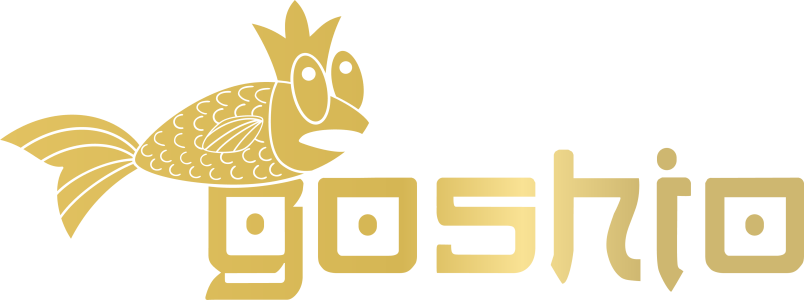The Fabulous Fable of Goshio the Goldfish
Jaroslavs Kaplans

A BUSINESS TALE



with a Spark of Wisdom

Water, water every where, nor any drop to drink…
From The Rime of the Ancient Mariner
by Samuel Taylor Coleridge
From The Rime of the Ancient Mariner
by Samuel Taylor Coleridge
Imagine, my Dear Reader, a truly immense aquarium, where you and I will find a sincerely nice (in every manner) and truly magical goldfish by the name of Goshio.
LET'S IMAGINE…



While inside this huge wonder-aquarium, Goshio the goldfish can independently choose her own direction of motion, speed and even the depth of her travels. In this regard, we can consider our goldfish a true sovereign of her own life – after all, she makes all of her own decisions: the temperature she keeps in the aquarium, the lunch and dinner she savors, the friends and enemies she chooses, the level of oxygen the goldfish maintains in her habitat, the type of grass (or algae) she wants planted on the aquarium floor, etc.






AN INDEPENDENT goldfish?




Inside the aquarium, our goldfish has everything under control (or so she believes):
-temperature
-food
-level of oxygen
- the behavior of other fishes in the aquarium
-temperature
-food
-level of oxygen
- the behavior of other fishes in the aquarium

Everywhere inside the aquarium the goldfish is independent

There is just one "insignificant" problem in Goshio's life.
JUST ONE "SLIGHT"

PROBLEM
It turns out that the aquarium she lives in and courses through has its own motion – motion that the goldfish is only faintly aware of and does not understand.
THE AQUARIUM HAS ITS OWN MOTION








Oh, but this is not surprising – despite the name of the story, our fabulous aquarium is hardly in a fable, and our marvelous goldfish is not quite in a fairy-tale world…No, the aquarium is to be found on a very specific meridian M, on a rather fashionable parallel P in country N (or, perhaps, in the "country" of wondrous and wandering ocean waves) on planet Earth – third planet from the Sun in a galaxy with the rather curious name of Milky Way.
THE AQUARIUM EXISTS IN THE REAL WORLD
Our planet revolves around the Sun and spins on its own axis, and all things on Earth revolve and spin right along with it (trying not to go spinny). This includes our (or rather, Goshio's) aquarium, of course. These revolutions bring about the natural phenomena that people witness daily, like the relays of sunrise and sunset, the waltz of night and day, the moon sonata of the tides and the never-ending merry-go-round of the seasons. But for our Goshio, sunrise is simply sunrise and sunset is only sunset – really, what does the planet's revolution have to do with any of this?

But even as you, My Most Esteemed Reader, read these very lines at this precise moment, you are continuously moving due to our planet's motion.
Our goldfish pays little attention to what goes on in the "other world" – one outside of her aquarium, for she is fully immersed (in every sense) in what goes on inside; and let me assure you, her aquarian world truly is very eventful. The goldfish finds little rhyme or reason in the "foggy" idea that the world outside the aquarium also merits her careful attention. This worldview Goshio holds to steadfastly often proves perilous to her own magic self, since the environment can influence our heroine's fate to a large degree.









AQUARIUM
APARTMENT / HOUSE
CITY / COUNTRY
PLANET
GALAXY






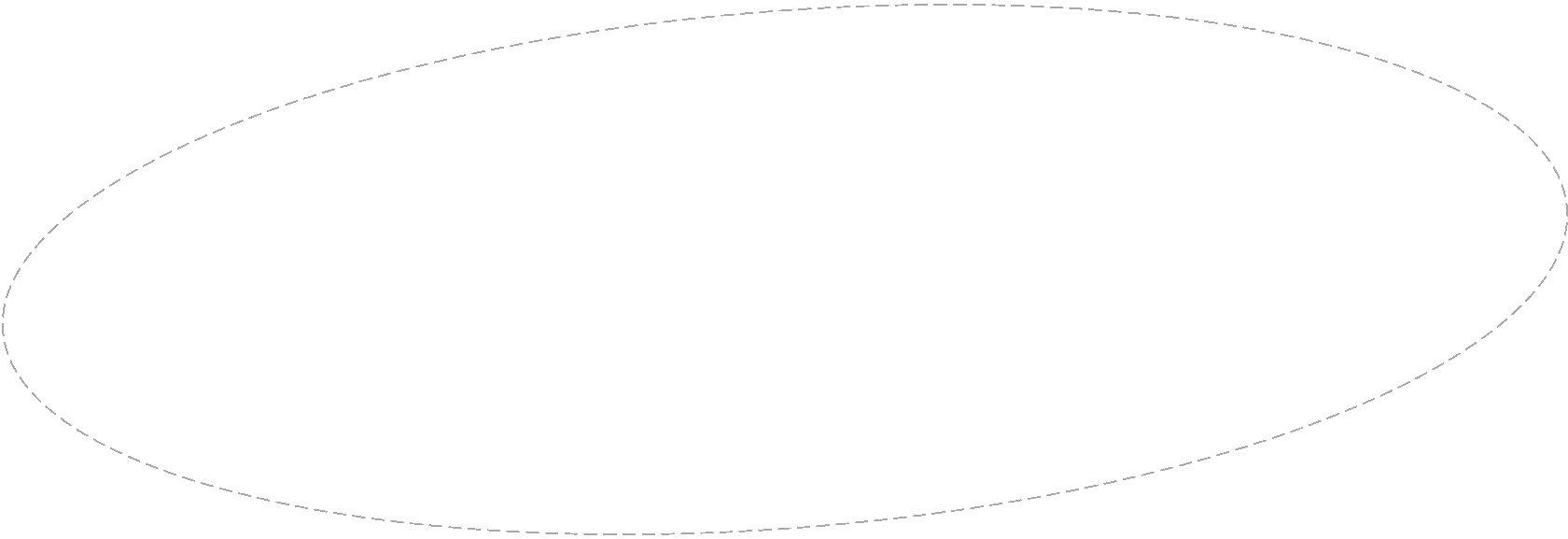

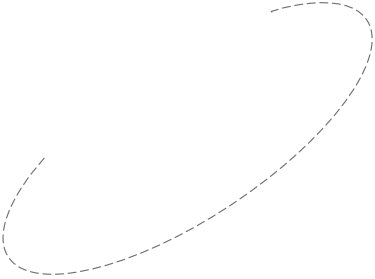










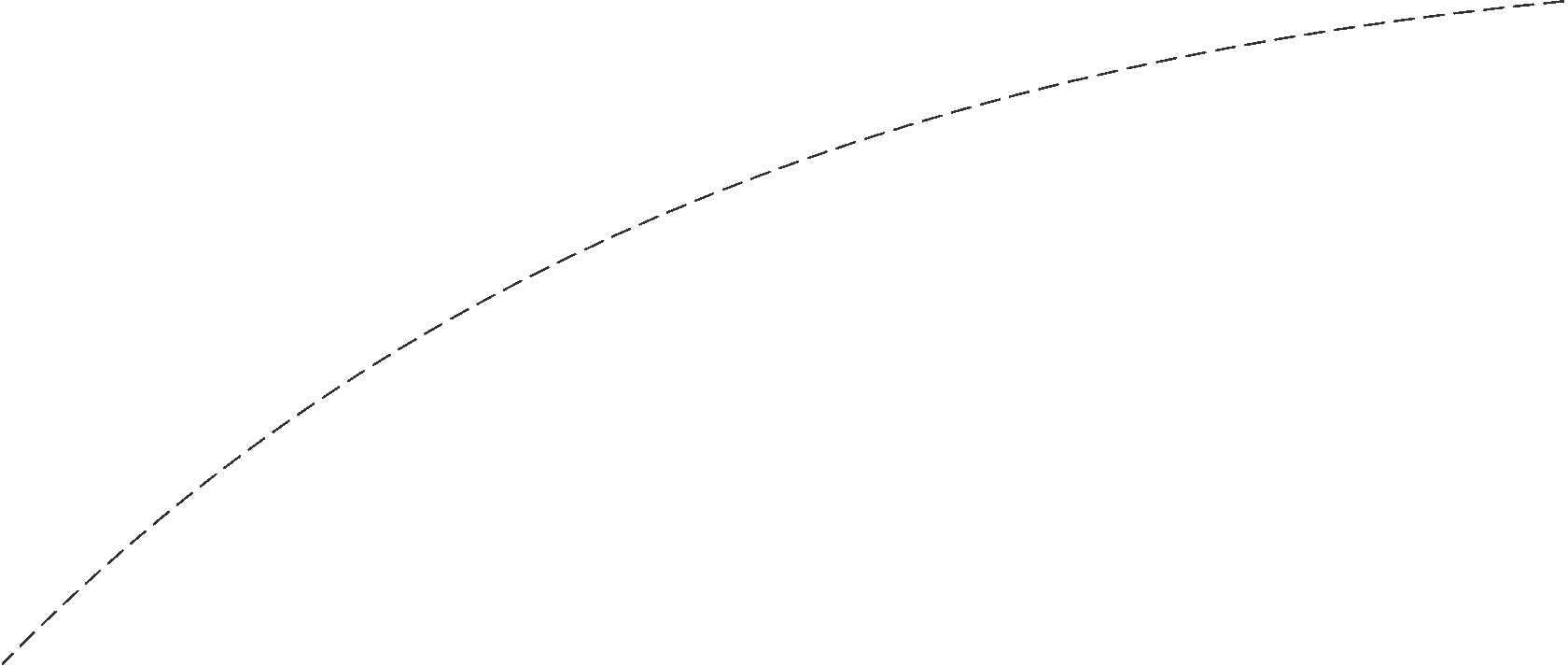

YOU ARE ALSO CONTINUOUSLY MOVING


















(even if you are no aware of it)

To illustrate the point: say the outside temperature takes a sudden dive – this would mean that the warm waters of the aquarium would swiftly cool down and even freeze, together with the goldfish Goshio, mind you. This happens even if the goldfish knows nothing whatsoever about outside temperature.
OUTSIDE CHANGES AFFECT THE AQUARIUM
To make it very clear, by "environment" here I mean the world outside of the familiar aquarium, the "paraquarian" world versus the immediate surroundings of the goldfish (within the aquarium).
You might ask, Dear Reader, justly and justifiably, how in the world did Goshio's aquarium end up in the middle of nowhere and everywhere, in Poseidon's kingdom. Who knows? – It may have been a stray squall that kidnapped her from a comfy cozy home, or maybe a tornado.
All right…Unaware of the outside world, our goldfish is also ignorant of her own aquarium's motion through some "other" space – well, perhaps she has a faint subconscious idea that "there is something out there." Nevertheless, the aquarium's own motion, unpredictable and treacherous at times, creates little and big troubles for our dear little goldfish.





NOW IT'S COLD





NOW IT'S HOT



SOMETHING
ELSE HAPPENED
ELSE HAPPENED






















100 KM/H
10 KM/H
NORTH
SOUTH
Let us say that our goldfish decided the time was ripe to enjoy life, take a breather from her very important and vital affairs and go on a vacation in warm and inviting southern waters. Done deal! She starts swimming south with a velocity of, say, 10 km/hour. Alas, woe unto the goldfish, the aquarium itself, unbeknownst to our heroine, begins moving due north with a speed of 100 km/hour, impelled by a force of which the "traveleress" is not aware.


AQUARIA
PARAQUARIA
(terra incognita)
MAP of GOSHIO'S WORLD











SUDDEN CHANGE
Where AM I?!



WHAT'S THE REASON FOR THIS CHANGE?
BEFORE
NOW
(sudden and unexpected)
Possibly, she has always been there. It is, after all, a fable, and Goshio is, indeed, a magical goldfish. So let us simply agree to leave this phenomenon unexplored and unexplained for now and carry on with our story.
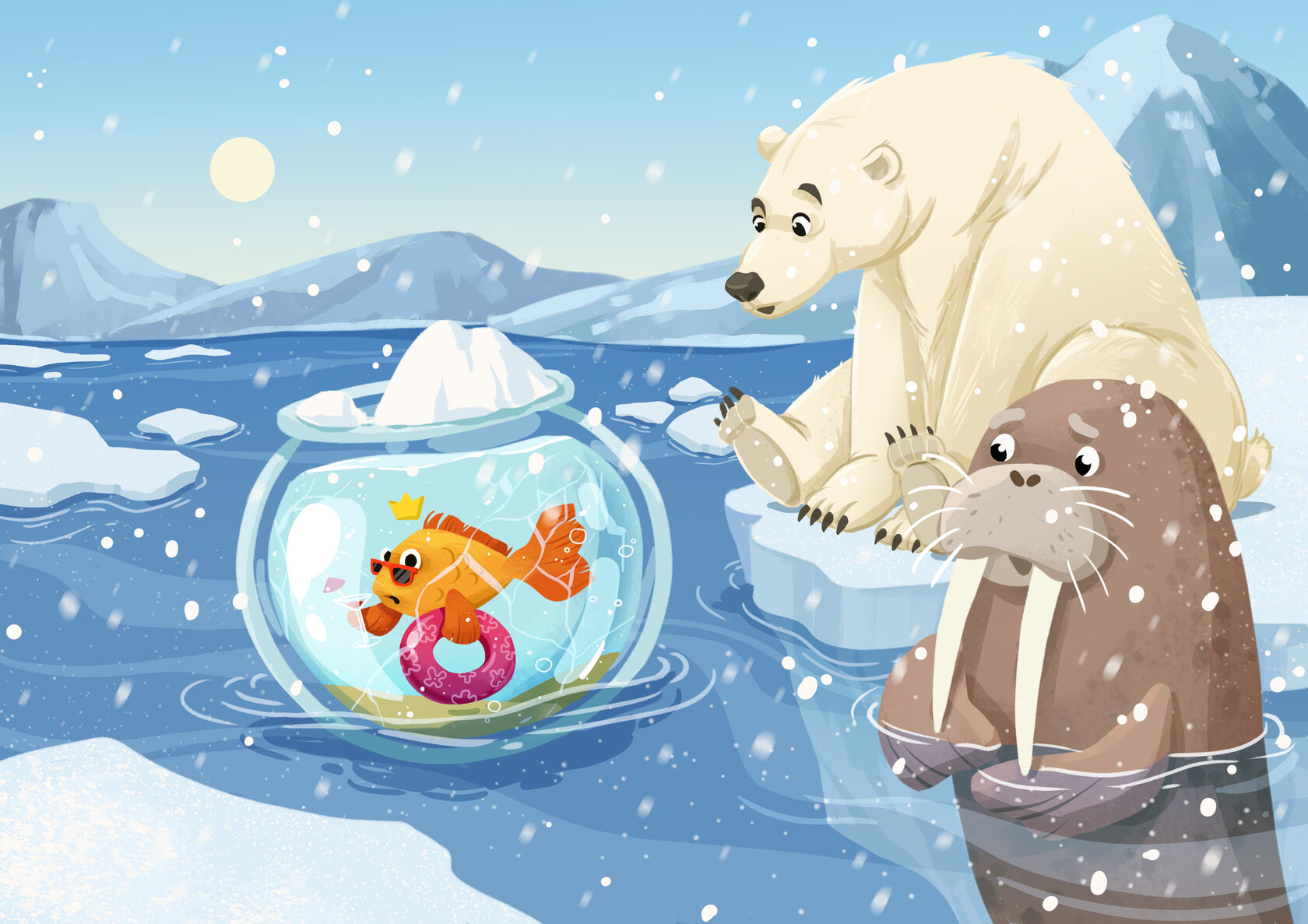
Here she is, diligently swimming on and on towards an encounter with the warm, caressing currents of the southern waters (guided by her shining Northern Star), expecting to bathe and bask in the friendly waves, breathe in the unbelievable beauty and serenity of the sea…But all around – only storming tempests, whirling hurricanes and pouring chilly rain. An eternity goes by while our Goshio struggles with the unrelenting elements, failing to reach the destination and her innermost sacred desire: to relish in the well-deserved calm, cozy and serene waves of the southern seas.
In our allegory, the aquarium is the business in which the Entrepreneur (Goldfish) lives and operates. It is the Entrepreneur's natural habitat, and it is also the "natural corral" placing bounds on the "liberty of swimming" – bounds that the Entrepreneur grasped very well at the very outset of his or her career.






WHERE AM I??!
Paraphrasing Samuel Coleridge's famous lines, "Water, water every where and no need to think…".
"Water, water every where..." So why study anything but water? you have always thought. And this holds very true – until such time when the seagull dives down and pulls our goldfish out of the waves. In two seconds, Goshio comes to the brilliant yet horrid realization that water is not the only thing in the world.
"Water, water every where..." So why study anything but water? you have always thought. And this holds very true – until such time when the seagull dives down and pulls our goldfish out of the waves. In two seconds, Goshio comes to the brilliant yet horrid realization that water is not the only thing in the world.
Oh, but what a pity…Can you imagine the dismay of our independent and business-minded goldfish?















AQUARIUM
FACTORY













Everything is clear and familiar



Where am I?
And if you happen to be one of these little fishies, then you have been living and breathing water all your life. All you have ever known or seen is water. From the very first inhale of your gills, there was naught but water all around. And your daddy-fish and mommy-fish spoke only of water – in the immaculate Aquarian dialect, mind you. Your aunts and uncles, brothers and sisters and even distant cousins have been, are and will be living happily ever after in water. Not for a moment has a drop of doubt trickled into your mind, whether you were living in water or not.

















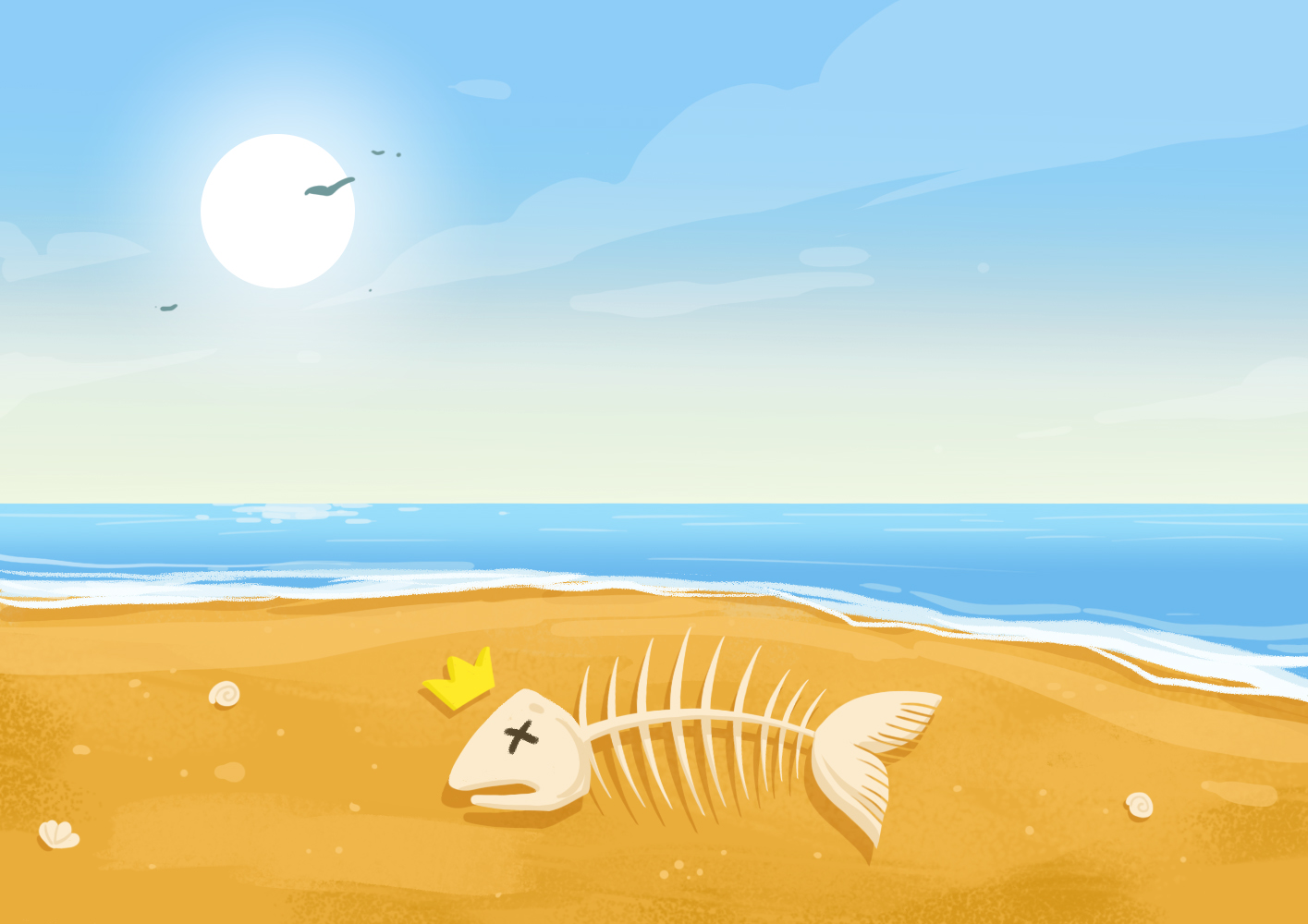
Think about this:
If your whole career you have worked in manufacturing, then manufacturing is your "water." All you know is manufacturing. Your father and your father's father worked in manufacturing. Manufacturing is what you studied in college, and your first internship was at a factory manufacturing goods. Over the course of thirty years, all you have ever known or done were the conveyor and manufacturing. And so, you assume that all things around you are nothing but manufacturing.
If your whole career you have worked in manufacturing, then manufacturing is your "water." All you know is manufacturing. Your father and your father's father worked in manufacturing. Manufacturing is what you studied in college, and your first internship was at a factory manufacturing goods. Over the course of thirty years, all you have ever known or done were the conveyor and manufacturing. And so, you assume that all things around you are nothing but manufacturing.
Our dear goldfish has so little connection to the outside world that she knows hardly a thing about it. Her self-sufficient and "autonomous" existence, independent (she believes) of the "paraquarian" world, does not seem too shabby. The idea that the aquarium might have its own motion not subject to her wishes has always been too incredible and esoteric a concept for her strictly pragmatic mind.
Goshio knows with great certainty that inside her aquarium She is a true and regal Queen and does all she pleases (well, almost). To her, this point is quite and very
non-neGoshioble. However, the idea that there is something else existing in that far, surreal distance beyond the aquarium walls has occurred to her a time or two (or three, at best) – and even then, it was a faint and foggy dream.
non-neGoshioble. However, the idea that there is something else existing in that far, surreal distance beyond the aquarium walls has occurred to her a time or two (or three, at best) – and even then, it was a faint and foggy dream.
To quote Jack Welch, the legendary CEO of General Electric: "If the rate of change on the outside exceeds the rate of change on the inside, the end is near."
And then she is dead.
THE VERY NEXT DAY
ONE DAY
For dear little Goshio, life simply goes on. One day, the aquarium currents are calm, serene and ripple-free – like a large, even, crystal-clear mirror. But the very next day, it all changes in a whirl. A gusty wind blows out of nowhere and the water grows murky-green; occasionally, it turns an ominously dark shade of blue, and there are even times when it appears a stark and startling black. Other fish, seashells and sand all disappear from view in the blink of an eye – only raving, raging waves remain, crushing everything in sight.
YOUR BUSINESS IS YOUR AQUARIUM









Family
Education
Internship
Career
Running the Business














— One's Sphere of Influence, Competence and Interest
— Sphere Beyond One's Control




















CONNECTION OF THE GOLDFISH (NOT THE AQUARIUM) WITH THE OUTSIDE WORLD
is fragile and unstable
Area of the Unknown






TRAGIC RESULT


JACK WELCH
CEO of General Electric
(1981—2001)
(1981—2001)
If the rate of change on the outside exceeds the rate of change on the inside, the end is near
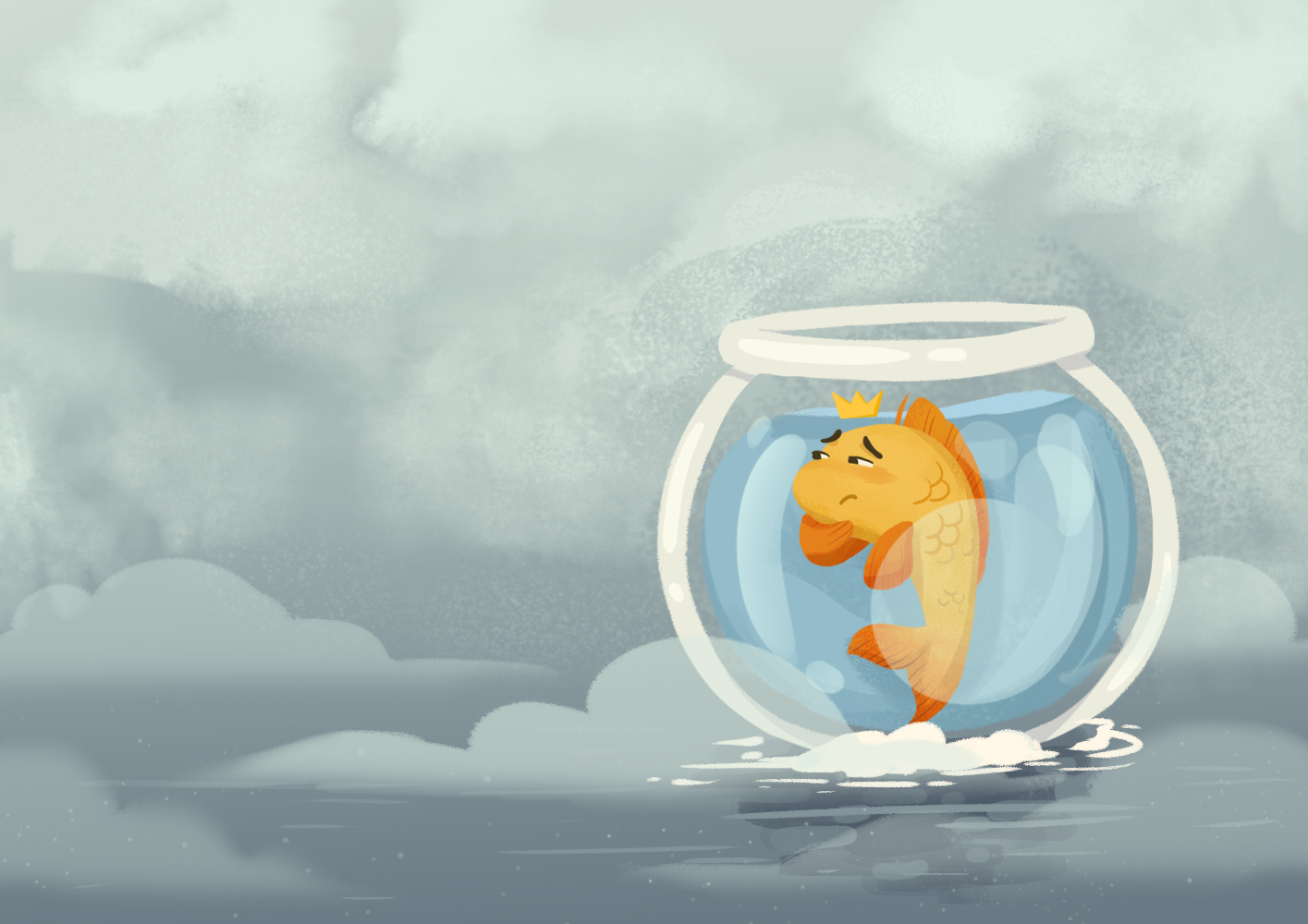
At times, our Goshio finds life within her aquarium mighty hard. What should she do at such a time? Well, all she can do is believe with all her might that all will be well in this best of all possible worlds.
Here Goshio reminisces on her French classes of long ago and thinks to herself, C'est la vie (that's life). Indeed, she believes that this is "just the way the world works," that things are the way they are by the laws of Nature herself. Not to mention, there is a never-ending tide of doubts, fears of the future, regrets of "fruitless, aimless years" and an infinite rehashing of her own former feats…
All too often, a creeping suspicion swells up in the mind of our dear goldfish that an impish, grinning devil must be wickedly wedging himself between her and the deep blue sea beyond – hindering, conjuring and interfering.
And that, my friends, is the true problem of our goldfish – to wit, she knows next to nothing about the changes on the outside. She cannot observe or recognize them…yet.
Once upon a time, I was such a goldfish too…But when I discovered that my "aquarium" was moving, as it turned out, without my knowledge or consent, I grew more and more interested in this question: Who? (and also, Why? How? and Where?) is moving our aquariums with nice – in many ways – goldfishes (Entrepreneurs) in them.



























THE AQUARIUM IS MOVING












THAT'S LIFE?
WHAT AFFECTS US?
I am afraid this will hardly help our brave and fabulous heroine. On top of her gallant efforts, she would also have to choose the right way to exert those efforts. For example, if only Goshio knew that her aquarium was, in fact, moving due north, that she, too, was heading straight for the Arctic, she could take the necessary steps to insulate her vessel and find a place to buy a comfortable, warm (and very elegant) fur coat instead of the fancy bathing suit she recently acquired – fashionable bathing suits don't help much in polar waters...
When a mysterious current at last brings our unsuspecting goldfish to the North Pole (perhaps she did manage to escape the seagull – she is rather magical, mind you), Goshio nevertheless persists in her noble desire to reach those warm and kindly seas. And right before freezing to death in the icy, forbidding Arctic waters, shivering from the unrelenting cold, yet pulling together all the might of her half-frozen gold-fishy brain, our courageous heroine sensibly concludes that she simply needs to increase her southward velocity from 10 to 11 km/hour or even, mind you, 12 km/hour. In the eyes of our practical-minded goldfish, this is oh-so-very-logical – after all, she need only exert a tad more effort to solve her problem and attain the result. Isn't that so?
Curiously, any time there is a storm at sea, our Goshio wonders most sincerely what is happening to her and why Fate is sending her all these vicissitudes of her aquarian fortune.
Every time that Entrepreneurs around me faced a new storm like losing market share, dropping sales, growing competition, low employee engagement, etc., they would offer a solution from a location "within the aquarium." Little did they know that it was not only the waters of their home aquarium – not so much those dearest waters – that implored their attention and their understanding, but rather the elements that lay beyond the well-known, familiar currents – out there, in the boundless "Market Lands" of the paraquarian world.
But as it stands (or flows), she is doomed to remain forever in this realm of unpredictable and precarious currents…and freeze sooner or later in these harsh, biting and hostile waters. But what do you think about all this, My Dear Reader?





SALES
COMPETITION
MOTIVATION


Shifting things around on the inside isn't helping

































I have to swim faster!






I must endure and keep going!











t = -30F












?
UNDERSTANDING THE SITUATION MAKES PLANNING EASIER
?
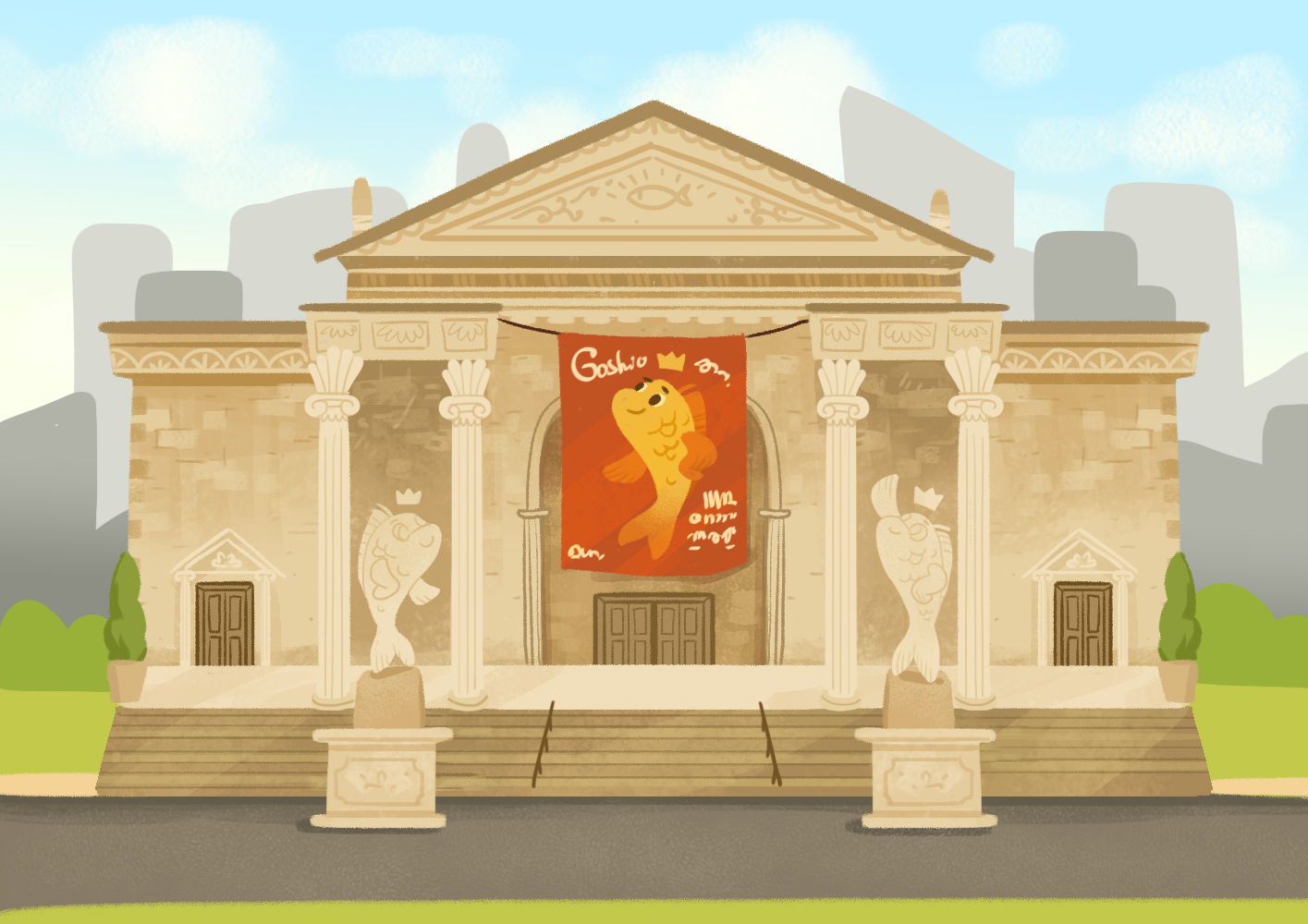
While 500 years have passed since the moment when Da Vinci formulated the principle above, we can confidently repeat his advice not only for artists, but also for all modern entrepreneurs. For six years now, I have been conducting extensive research into the reasons behind the high "business mortality rate" among Entrepreneurs and came upon a very fascinating and vital question in the philosophy of entrepreneurship: What is the best viewpoint from which to perceive one's own sphere of activity – a viewpoint that would help Entrepreneurs find new opportunities for themselves and for their future Customers?
Perspective is the guide and the gateway; and without this nothing can be done well…
Leonardo Da Vinci (1452-1519)
Leonardo Da Vinci (1452-1519)
Part Two: Middleword (Passageway to the Picture Gallery)
Should you wish to reunite with Goshio as swiftly as possible, My Reader, feel free to navigate around the Middleword and proceed straight to Part Three, The Picture Gallery of Entrepreneurial Realities. But if you care to find out why it is a "Picture Gallery," and if you wish to get a glimpse into the history of this story, then bear with me for a page, or two, or three. Who knows? – you just might find it intriguing. And Goshio will still be swimming along in cold, warm or tepid waters, I promise…
















LEONARDO DA VINCI
Entrepreneurial
Activities
Activities
Perspective is the guide and the gateway;
and without this nothing can be done well…
and without this nothing can be done well…












WHAT IS THE BEST VIEWPOINT TO SEE OPPORTUNITIES
brilliant artis
(1452-1519)
(1452-1519)

And here I would like to draw several parallels between these worlds – art and entrepreneurship – for the two have much in common. Both in entrepreneurship and in art, the viewpoint chosen determines one's particular paradigm of thinking – especially when it comes to things that influence one's convictions, worldview and even the condition of one's existence.
Indeed, in the early 1900s Picasso described his approach to art in this fashion:
"I paint objects as I think them, not as I see them."
"I paint objects as I think them, not as I see them."
In art, there is a difference between reality and the artwork depicting that reality. This difference is further emphasized through the artist's own view of the world around them. Ever since the Renaissance, European painters have striven to create an illusion of three-dimensional space in their drawings and paintings. They wanted the beholder to see the painting just as if observing it from one specific location – for example, looking in or out through a window at an existing scene, interior, person or object. Yet when the beginning of the 20th century rolled in, bringing developments in quantum physics and in the theory of relativity, new movements were born in the visual arts – movements disavowing the doctrine of only one proper viewpoint. Possibly, Dear Reader, you have already guessed what I am about to describe: Cubism. While you may or may not know the intricacies of the Cubist movement, you have probably heard of its key figures like Pablo Picasso, George Braque and Jean Metzinger. The main distinguishing trait of Cubism is its rift with classical traditions of painting: specifically, acknowledging the importance of multiple viewpoints and thus bringing about the perception of simultaneity while observing the "whole object."
The perspective chosen is a unique phenomenon in that it encompasses, for the observer, all of space and time. Curiously, the word "perspective" comes from the Latin perspicere, and it means "to gaze closely, see clearly, look through." In the world of art, as opposed to the world of Entrepreneurship, the question of perspective is not considered something novel or original.



SUCCESS
DEPENDS ON THE PERSPECTIVE
DEPENDS ON THE PERSPECTIVE
PERSPECTIVE
"to look through". A word that describes the viewpoint chosen, as well a way to portray objects on a 2-dimensional surface yet give them the impression of distance, depth and volume in general.
From the Latin perspicere











Artist
Entrepreneur
People
Observed object
VISION
(Perspective)






ON REALITY AND THE ILLUSTRATION
(DEPICTING that REALITY)


CLASSICISM
CUBISM
Object is "observed as a whole"


PABLO PICASSO
brilliant artist
(1887–1973)
(1887–1973)
I paint objects as I think them, not as I see them
Artwork
Product
My main source of artistic inspiration was Pablo Picasso. In fact, it was his painting, Les Demoiselles d'Avignon (The Young Ladies of Avignon), that inspired me to write this fable. Over a hundred years ago, Picasso spoke these words: "In my opinion to search means nothing in painting. To find, is the thing."
Albert Einstein said: "Imagination is more important than knowledge. For knowledge is limited, whereas imagination embraces the entire world, stimulating progress, giving birth to evolution."
There is a crucial principle having to do with creativity: creativity is not bound by the limits of known human experience or by generally established algorithms. It is based neither on logic, nor on mathematics and it exists, first and foremost, in the realm of imagination – the Muse of all art. Creativity is that very "bridge" between art and entrepreneurship.
Artists of Cubism would depict an object the way they envisioned it – in its entirety, and from all aspects at once. They would no longer simply draw a basket of fruit (or a vase of sunflowers) the way they perceived it with their own two eyes – rather, they depicted each side of the object at the same time. Such simultaneous representation of various facets of reality, portraying objects from various viewpoints, was an avant-garde approach in art. When pondering this outlook on art, I saw a vast opportunity to compare the worldview of the Cubist artist with that of the Entrepreneur. I can confidently say that it was the Cubist's revolutionary perspective of multiple perspectives and viewpoints that inspired me to search for new points of view in my own sphere of activity, Entrepreneurship. Nevertheless, the main motif of this Cubism analogy lies in yet another idea. In the technique of Cubist artists, I saw an unbelievable opportunity to transform an infinity of entrepreneurial ponderings about "should-be-done"s into new viewpoints and perspectives. These fresh new viewpoints give birth to various observations, which in turn bring about new discoveries. Indeed, that is the central idea of the story you are reading: demonstrating to Entrepreneurs the existence of multiple perspectives and diverse viewpoints regarding their activities and their interaction with the environment. This understanding enables them to find new and creative solutions.














VIEWING THE OBJECT FROM ALL ANGLES SIMULTANEOUSLY
SIMILAR PERSPECTIVE IS NECESSARY IN ENTREPRENEURSHIP










LOGIC
ANALYSIS
EXPERIENCE
IMAGINATION


ALBERT EINSTEIN
Eminent physicist, Nobel Prize Laureate, Father of the Theory of Relativity
(1879–1955)
(1879–1955)
Imagination is more important than knowledge. For knowledge is limited, whereas imagination embraces the entire world, stimulating progress, giving birth to evolution


PABLO PICASSO
Brilliant Artist
(1887–1973)
(1887–1973)



The Young Ladies of Avignon
In my opinion to search means nothing in painting. To find, is the thing.
ON IMPORTANCE OF COMPLEX PERCEPTION




ART AND ENTREPRENEURSHIP

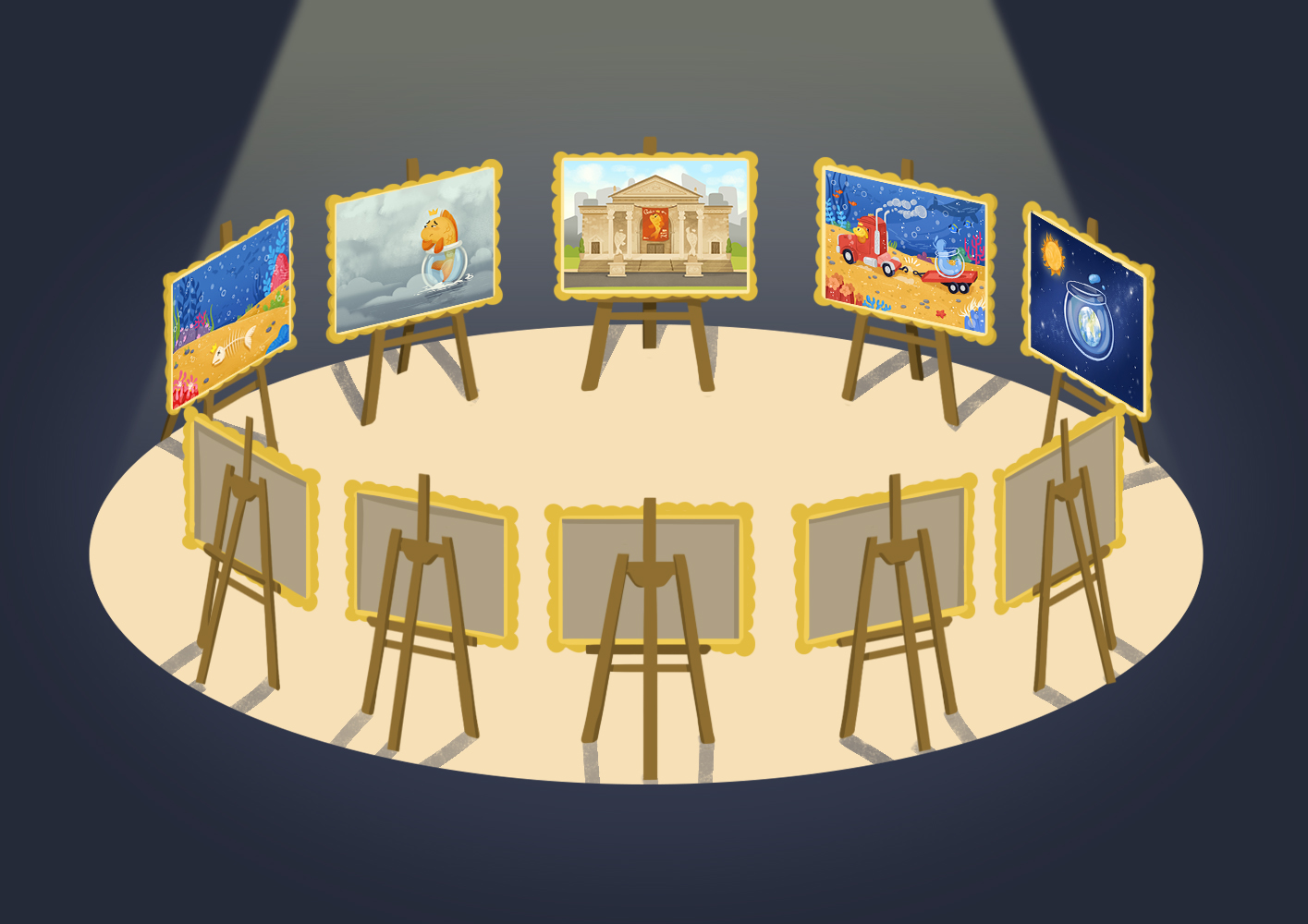
All the Observations are intimately related, often making it difficult to distinguish between them, since they are, after all, various angles on the same "object" (Entrepreneurship) – simply from different viewpoints. Likewise, in the real world of Entrepreneurship, all these thoughts, considerations, ideas, perceptions and feelings about business often interweave into complex and intricate quilts, creating all sorts of particularities and peculiarities in the mentalities of goldfishes – less allegorically, in the worldviews of Entrepreneurs. But at the same time, every Observation-Painting focuses on one unique "scene" of entrepreneurial mentality, making it possible for my reader-viewer to consider "The Worldview of Entrepreneurship" panorama from various and, at times, very surprising viewpoints.
Part Three: The Goshio Picture Gallery of Entrepreneurial Realities
You cannot imagine, my Dear Reader, how glad I am to warmly welcome you, on Goshio's behalf, into our marvelous Gallery of Observation-Paintings. May you discover, quoting the words attributed to the great French philosopher Denis Diderot, "the marvelous in the familiar and the familiar in the marvelous."
Observation-Paintings are the artistic jewels of our gallery, while new or various Realities are at the heart of all art (and of entrepreneurship as well). Two viewpoints, two descriptions… And now without further ado, let us pay the homage due to the Picture Gallery.
Following his advice, I have been striving to find my own perspective and viewpoint on Entrepreneurship. I do trust that I have succeeded to a marked degree, but the search is far from over. And I believe it is important and helpful to share my findings with the Reader and the Entrepreneur. In this book, each of the viewpoints is presented as a painting depicting a particular Observation, which in turn gives the reader (or viewer?) a unique perspective on his or her activities. The exposition of these Observation-Paintings reveals to the reader-viewers, from various aspects and diverse viewpoints, a 360-degree panorama of their own activities – much like the work of a Cubist artist would. As an analogy, we could imagine that the reader is visiting a virtual exhibition. In this imaginary yet possibly very real picture gallery, one would find a myriad of such Observation-Paintings – a term I use to describe various circumstances, facts and factors that influence the aquarium as a whole, as well as each particular result a goldfish (Entrepreneur) strives to achieve.
In case you have not yet ventured through the passageway to our Picture Gallery (in other words, if you haven't read the Middleword), or even if you have, let me say this much… After analyzing the possible strategies before our magical goldfish Goshio, I would like to share with you ten important Observations that, as I see it, will determine the future fate and happiness of our goldfish to a marked degree.















1.
2.
3.
4.
5.
6.
7.
8.
9.
10.

OBSERVATIONS
AND CONCLUSIONS
ON THE BEHAVIOR OF THE GOLDFISH GOSHIO
AND CONCLUSIONS
ON THE BEHAVIOR OF THE GOLDFISH GOSHIO













TEN OBSERVATION-PICTURES
3600
a panoramic perspective on the entrepreneurship

ALL PAINTINGS ARE RELATED
#1
#2
#3
#4
#5
#6
#7
#8
#9
#10












DENIS DIDEROT
writer, philosopher and educator
(1713–1784)
(1713–1784)
…find the marvelous in the familiar and the familiar in the marvelous.














of Entrepreneurial Realities
THE PICTURE GALLERY



A PAINTING FROM
THE GALLERY
THE GALLERY
of Entrepreneurial Realities
OBSERVATION-PAINTING
There is only one thing worse than this: such confidence often inflates first into cockiness and then swells up even further into a balloon of stupidity. And in my neck of the woods, the saying, somewhat liberally translated, goes like this: "Teaching an arrogant dummy is as useful as feeding a mummy." In the English-speaking world, people seem to be much gentler and say, "Advice is least heeded when most needed."
As an analogy, let us consider an enormous painting, and a smaller section of that artwork. An observer who is only able to perceive a miniscule portion of the painting is nonetheless fully confident of understanding the full picture, despite this truth – the whole painting is thousands of times greater than the section being observed.
Like Goshio, most people give no thought to Paraquaria – the environment around them (and outside the "aquarium"). This unawareness also extends to not even realizing that there is an environment around us. And yet, this environment, this world, does exist whether we take it into account or not.
Observation One:
Your Environment Matters
Your Environment Matters













WHAT SURROUNDS US?



AQUARIUM IS JUST
a small element
OF THE WHOLE PICTURE

PARAQUARIA


YOUR ENVIRONMENT MATTERS


CONFIDENCE
COCKINESS


TEACHING AN ARROGANT DUMMY IS AS USEFUL AS FEEDING A MUMMY





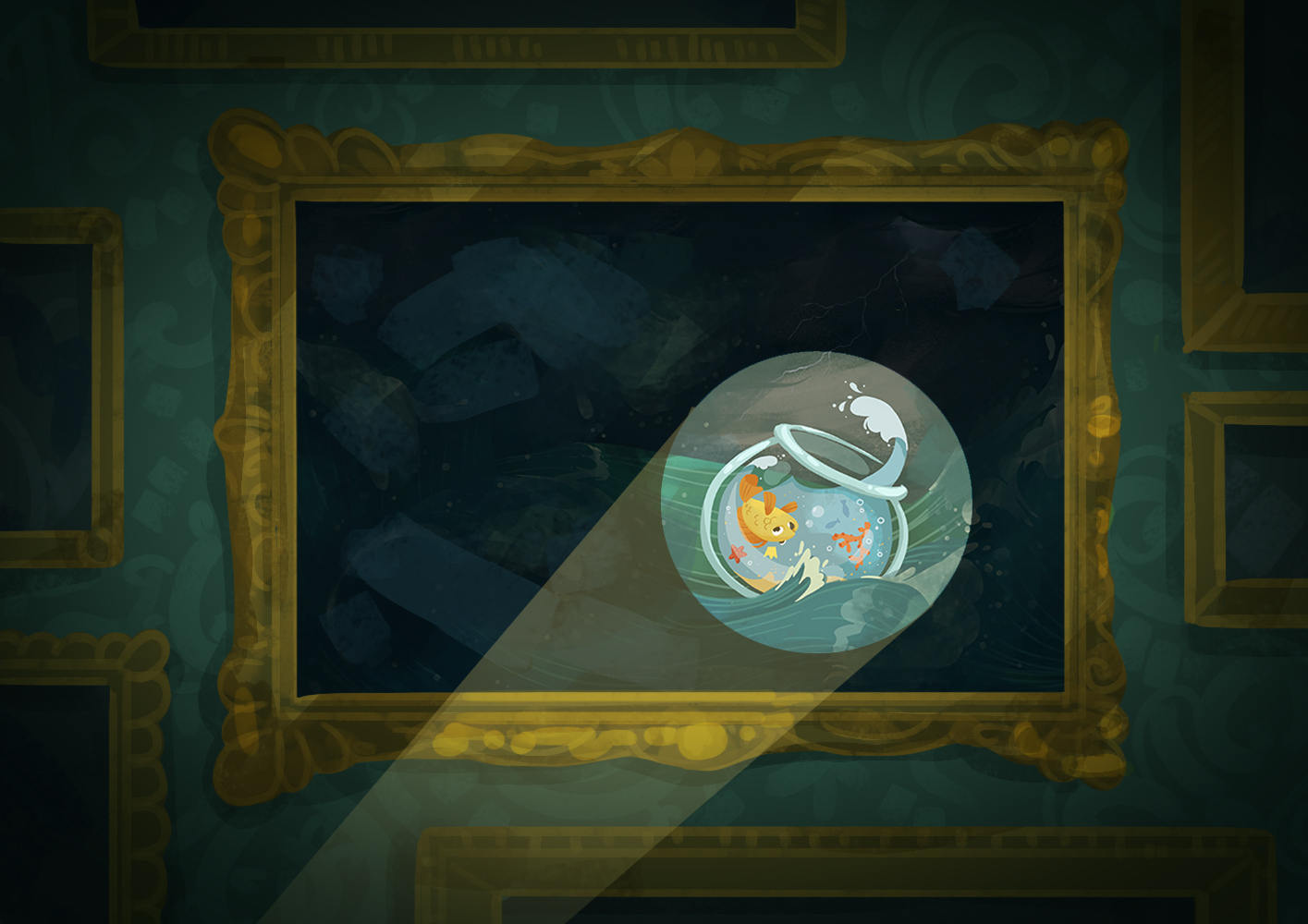
Just like our goldfish in her aquatic habitat, Entrepreneurs and their products do not live in a "cosmic vacuum," separate from consumers, in a world of their own and apart from some environment – no, they always exist in a very specific context of interaction with the consumers.
When Goshio beholds her environment from within the aquarium, she assumes that the life "out there," "overboard," is precisely the same as in her own Aquarian Seas. Indeed, the language, the mores, the customs and conduct of other fishes (citizens of Paraquaria) – all of it appears so similar, nearly identical to the world she knows, that our Goshio comes to a very "reasonable" conclusion that this great Paraquarian World is simply an inflated duplicate of her own aquarian universe. Goshio's opinion is likely to suffer a marked change should she meet a Portuguese man o' war "out there" (a very poisonous jelly fish nearly as venomous as a cobra), but let us hope she never does. Unfortunately, our little goldfish does not know this simple truth: life outside the aquarium is oceans different than the life within its walls.
Observation Two: Laws Aren't Universal
As American anthropologist Ralph Linton wisely said, "The last thing a fish would ever notice would be water."
















EXPECTATIONS
Out there it's just the same as inside my aquarium
REALITY
WORLD IS DIVERSE





LAWS
AREN'T UNIVERSAL
AREN'T UNIVERSAL













WATER
GOLDFISH
OTHER AQUATIC RESIDENTS
PRODUCT
CONTEXT of INTERACTION
CONSUMERS
ENTREPRENEUR/PRODUCT AND THE CONSUMER
are connected through the context of interaction

RALPH LINTON
American anthropologist
(1893—1953)
(1893—1953)
The last thing a fish would ever notice would be water




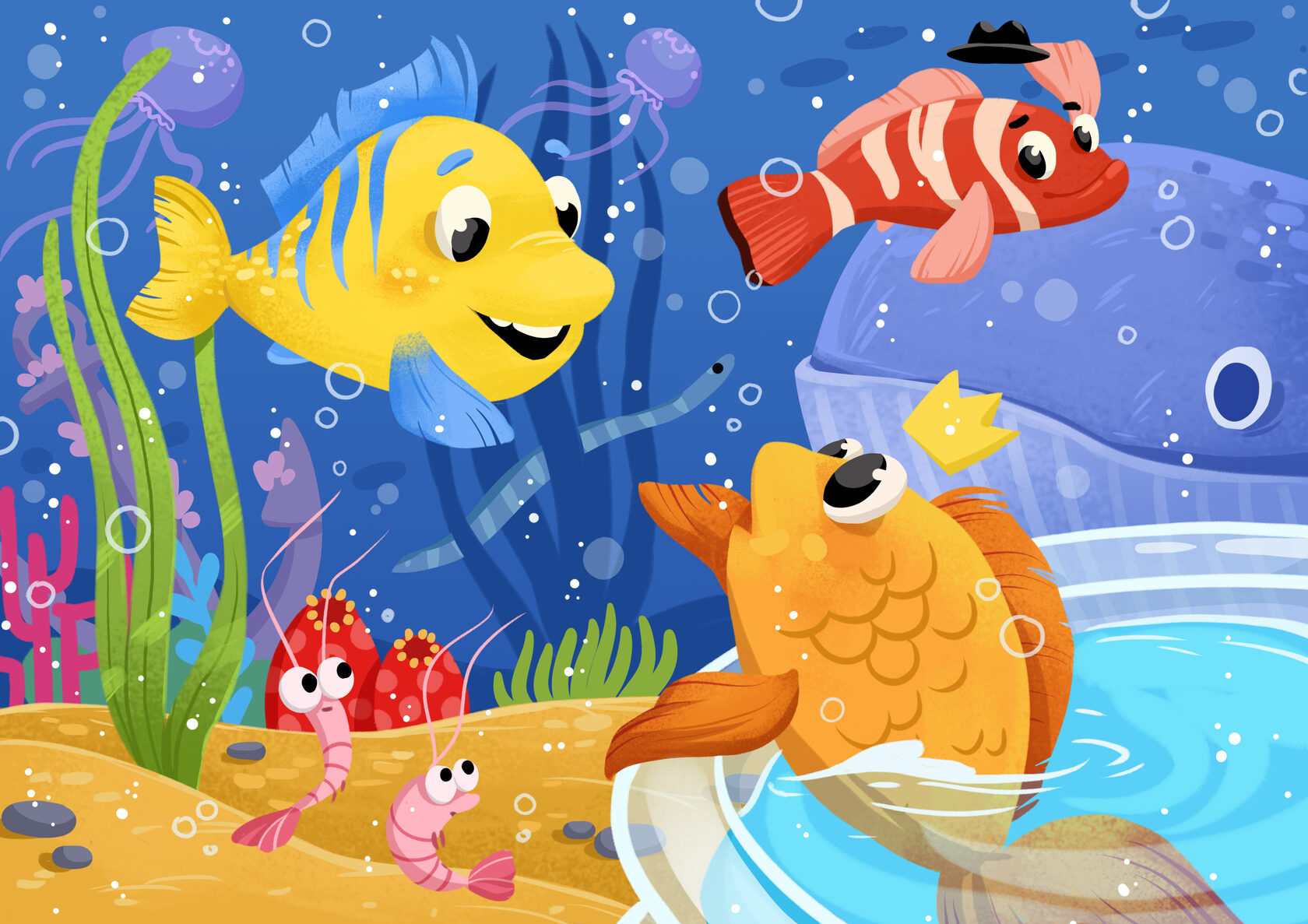
The second vantage point is considerably more effective. It is a panoramic view, spanning a wide angle of "scenery," and this angle allows the observer to see the interaction and interrelationship among the problem, the environment and self. But mainly, this outlook from beyond the aquarium permits our goldfish to have "connectedness" to her environment – after all, you can't find yourself in water without getting wet, right?
The first point of view (observing the problem from the same area where the problem exists) is the most disadvantageous position. It is practically impossible to see a "route to victory" from this viewpoint – the space is too narrow, hindering our goldfish from seeing an effective solution. We could say that the "field of view" over the problem is too narrow, inadequate for decision-making. (By field of view, I mean, of course: the panorama, the extent of what we see). One cannot behold Victory if one is not observing its full height and stature. Go ahead and try to inspect a large object (like a water bottle), which is right on your nose (literally speaking), just an inch or so away from your eyes. A bit difficult, isn't it? Even if a solution is found when someone studies the problem from the same area where the problem exists, there is a risk that the outcome might be like the well-known saying: "One could win the battle but lose the war."
One can evaluate things from different points of view (I'll also refer to this term as viewpoint, outlook and vantage point). Our knowledge or perception always depends on the viewpoint chosen: often, two people behold the same object yet their interpretations of it are worlds, or oceans, apart. When our goldfish encounters a problem in a certain area, she can observe this problem from two completely different viewpoints. The first point of view is when she perceives the problem from a point within the aquarium, while the second vantage point is outside the aquarium and at a distance from it.
Curious, is it not? Goshio knows very well that there is "water, water every where," and, nonetheless, she cannot fully or truly see even her most immediate surroundings – and that brings us right to our next and third observation. Observation Three: Be Where You Can See

CHOOSING THE RIGHT VIEWPOINT
















OBSERVING FROM THE INSIDE
(narrow angle)
OBSERVING FROM THE OUTSIDE
(wide angle)











AREA OF POSSIBLE SOLUTIONS


PROBLEM
You cannot see the solution from the same area where the problem exists
ON CHOOSING THE RIGHT VIEWPOINT
on the problem
on the problem







BE WHERE YOU CAN SEE






HOW ARE WE LOOKING AT THE PROBLEM?
And now, back to business. If one examines and analyzes these interactions among the problem, the environment, and the observer (self) – doing it from a point outside the problem area – then an effective solution can be discovered sooner. A possible result of this type of panoramic outlook over the problem might be a fundamentally new solution or even a new business model. For example, such an elementally new solution might mean "magically" transforming what most people consider to be expenses into a first-rate income source.
And now, go on and ask Goshio whether she loves her "Aquabarco" – the young lady would stare at us wide-eyed, her gold-fishean lashes blinking rapidly in bewilderment. She might, perhaps, know enough Spanish to understand that we were calling her home a "sea vessel" or the like, but she would definitely be confused – "My land? A ship? Not a chance!" But before you can utter "Aquaria," a kindly proud smile would grace her regal face. Thus, a difference in vantage points can mean all the difference. To some it is Aquaria, and to others – Aquabarco. Possibly, you can think of your own examples when people describe "the same thing" by various names, depending on the viewpoint chosen.
As you may have guessed, Aquaria is Goshio's realm, but it is essential to note that this is the name Goshio and her immediate retinue call this kingdom. From Goshio's viewpoint inside the aquarium, her kingdom is a vast and spacious aquatic world – most importantly, one that is stable and unshakable. All right, this is partially true – Aquaria is a beautiful country, which offers many opportunities to Goshio and her friends, yet… You and I both know well that Aquaria's condition is not so stable and unshakable during a chop at sea – after all, the environment affects it immensely. And so, when mariners and explorers observed this traveling, floating aquatic world from periscopes, submarines and hot air balloons, they "christened" it by the noble name of "Aquabarco." Some of them may understand "Aquaria," but only the savviest, most erudite ilk. The Paraquarian people at large know little about "Aquaria," but few there are who have not heard of the Racing Aquabarco – a vessel no less legendary, indeed, than the Flying Dutchman. Some call it Aquabarco the Errant, others (less lovingly) – Aquabarco the Erratic. There are those who serenade it as Lady of the Seas, and yet another school of thought calls it "Strangeness in the Night." Whatever the designation, Aquabarco is most certainly a phenomenon to be reckoned with.
The difference of viewpoints is well demonstrated in the Buddhist tale of the elephant and four blind men, who try to fathom the elephant by palpating various parts – the trunk, the tail, the legs and the sides. And each conceives a different version of what the elephant really is. A very wise parable, indeed. Yet, in our fable there is an even more revelatory example that has to do with Aquaria itself.
PROBLEM
PANORAMIC VIEW OVER THE PROBLEM






SOLUTION 1






SOLUTION 2
SOLUTION 3

SOLUTION N















THE PARABLE OF THE BLIND MEN AND THE ELEPHANT










viewpoint from inside the aquarium
viewpoint from land
NAMES AND UNDERSTANDING
THE SAME OBJECTS CAN HAVE DIFFERENT NAMES IN VARIOUS PLACES OR CIRCUMSTANCES







How do you love your errant "Aquabarco"?
My land? A ship? Not a chance!
ROUGH WATERS OF TRANSLATION




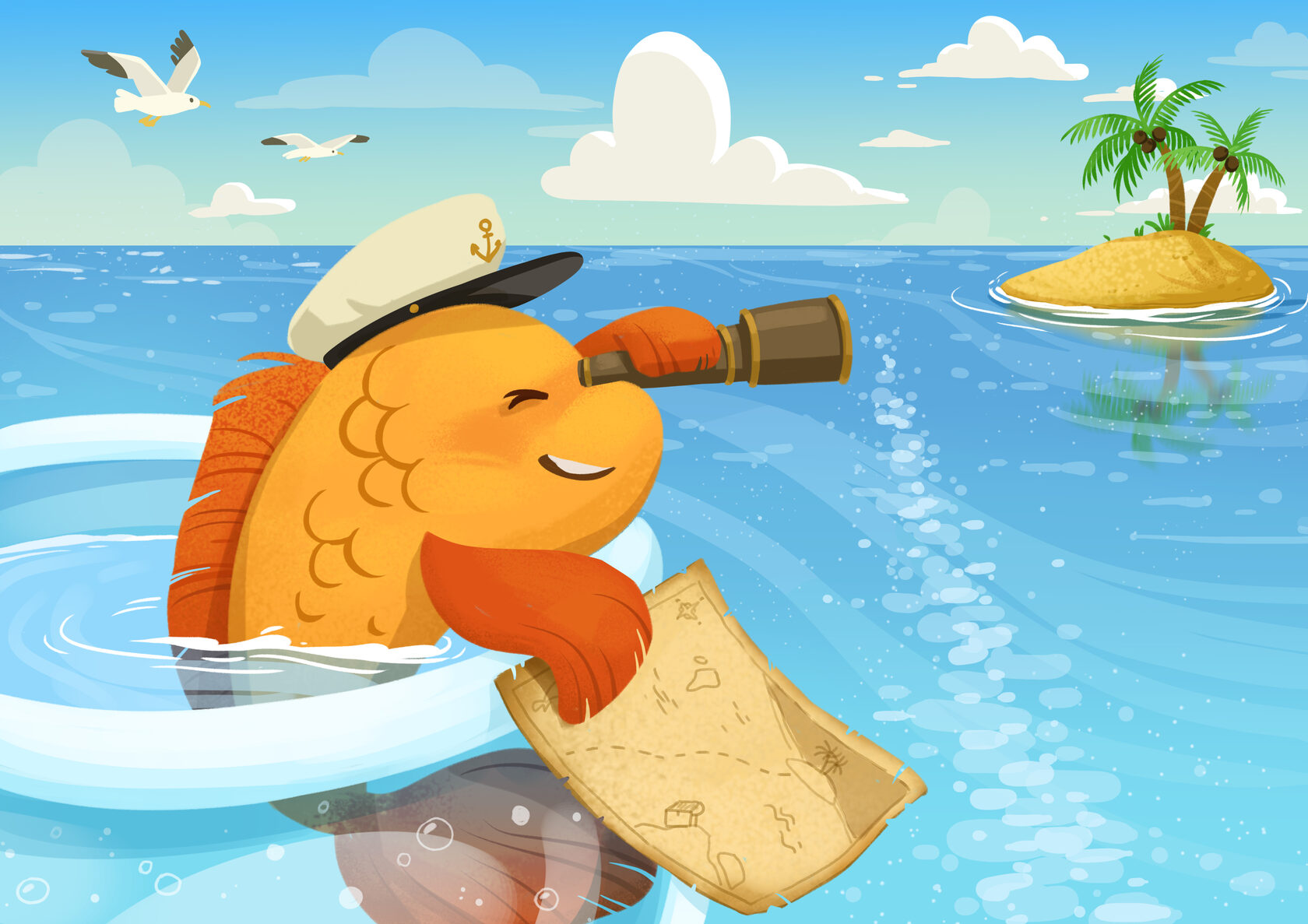
Observation Four derives from the previous one and it comes down to this: in order to move away from being a total effect-point of one's own environment, to shift from being utterly dependent on it, to earn "voting rights," Goshio needs to widen the walls of her own narrow aquarium and make room for a section of what used to be the environment.
To note a curious fact, anything devoid of such a connection, will inevitably be Effect in real life. Once, the fox said to the Little Prince: "Right now you're only a little boy to me, just like a hundred thousand other little boys. I do not need you, nor do you need me. To you, I am only a fox, just like a hundred thousand other foxes. But if you tame me, we will need each other. You will become the only person in the whole world to me and I will be the only fox to you…" Don't you think, My Dear Reader, he was wisely speaking of connection…?
The time-honored philosophic principle underlying this Observation could be laconically stated thus: the interplay of Cause and Effect exists only when there is a connection between the two. Lacking this connection, the "duet" of Cause and Effect does not exist. Therefore, it is the connection (the union, the link, the coupling, etc.) itself that brings the Cause and Effect relationship into being.
And that is the main error an Entrepreneur could make – developing the product or developing the clientele without building a durable bridge – an effective and reliable connection between the Entrepreneur and the Clientele. In this sense, Entrepreneurship is more about the creation of such connections between Entrepreneurs and their clients than about products or clients separately.
Observation Four: Cause, Effect and the Connection
But the idea of connection can also be easily demonstrated by using a more material example from towing. In the automobile industry, they use tractor units (cause) to tow trailers, semi-trailers and flatbed trailers (effect). If this union is missing, we have only potential cause and effect. Up until the point when the most powerful truck tractor in the world is hooked up to the trailer, this tractor will be no more than potential cause. What makes it true and bona-fide cause is its connection to the trailer.






IT IS NECESSARY TO EXPAND THE BORDERS OF THE AQUARIUM



ON IMPORTANCE OF CONNECTION
it is the connection itself that brings the Cause and Effect relationship into being






ON IMPORTANCE OF CONNECTION
EFFECT
CAUSE
POTENTIAL
CAUSE
CAUSE
POTENTIAL EFFECT


CONNECTION






PRODUCT

CONSUMERS


MISSING CONNECTION
A COMMON MISTAKE OF AN ENTREPRENEUR
CAUSE, EFFECT AND THE CONNECTION


Right now you're only a little boy to me, just like a hundred thousand other little boys. I do not need you, nor do you need me. To you, I am only a fox, just like a hundred thousand other foxes. But if you tame me, we will need each other. You will become the only person in the whole world to me and I will be the only fox to you…


EVERYTHING LACKING CONNECTION
becomes effect












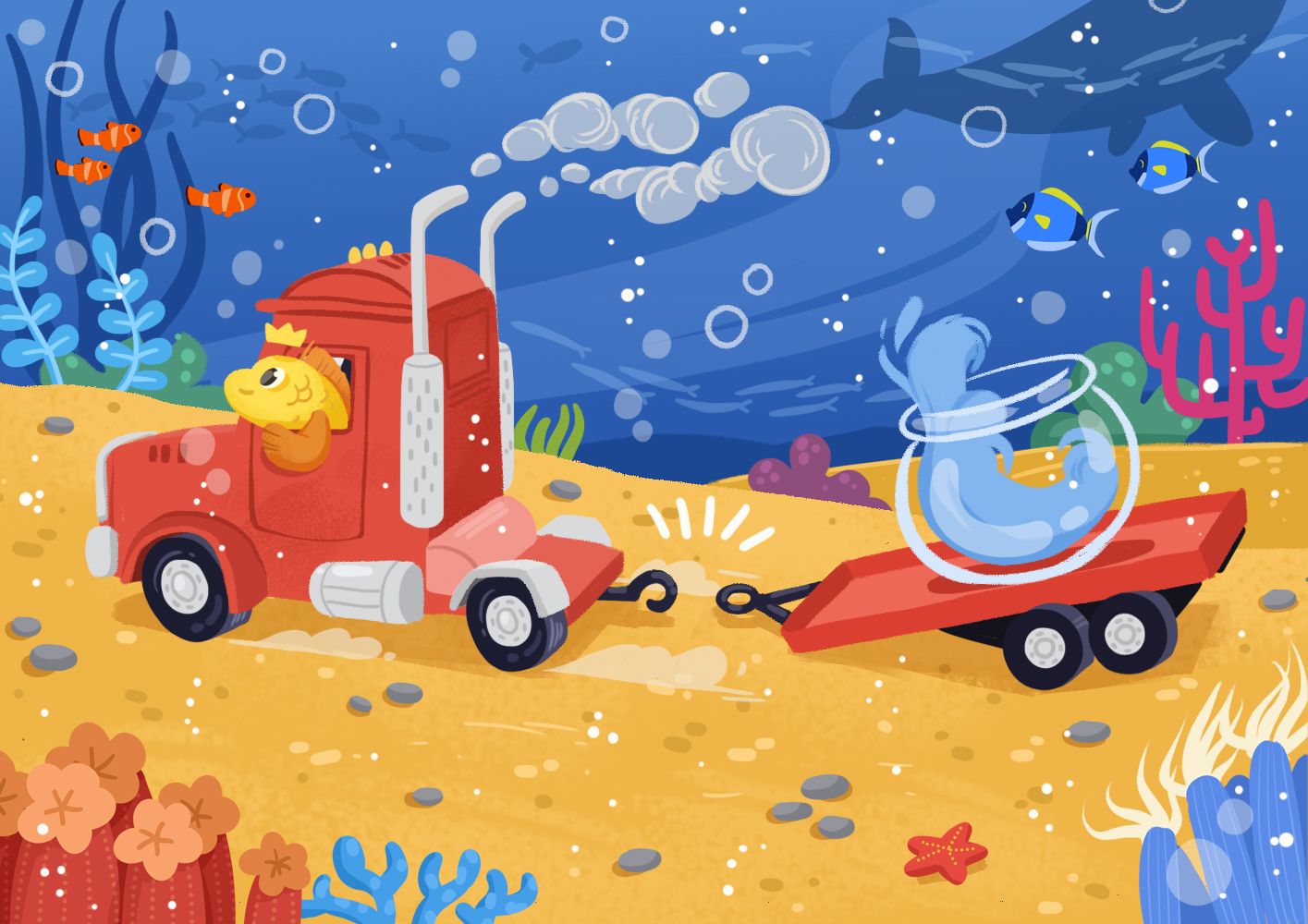
Observation Five: Expand the Bounds of Understanding
When Goshio expands the walls of her aquarium, broadening the space within, she also gains more control over the outside environment for the very simple reason that she was able to "annex" a part of the environment for her own aquarian needs. Besides, this new state of affairs allows her to broaden the field of view over her own surroundings – our heroine now has a better, wider angle of observation and can see more interactions within her own newly expanded aquarium.
When Goshio expands the walls of her aquarium, broadening the space within, she also gains more control over the outside environment for the very simple reason that she was able to "annex" a part of the environment for her own aquarian needs. Besides, this new state of affairs allows her to broaden the field of view over her own surroundings – our heroine now has a better, wider angle of observation and can see more interactions within her own newly expanded aquarium.





MORE EXPANSION = MORE CONTROL


ZONE OF CONTROL

It should be said that the space one commands (in one's mind, first and foremost) determines one's resources. The best of artists, scientists, rulers and entrepreneurs avail themselves of ideas and resources from all over the globe. You may or may not like Hollywood, but it certainly does attract talent from all corners, nooks and crannies of the planet. And, of course, one's space (playing field) is exactly where the interplay of Cause and Effect takes place. The relationship of Cause and Effect is a general principle of life, but in the entrepreneurial arena this transforms into the interaction between Entrepreneur and Client (where both are alternately Cause and Effect). And that's one way this trio of Observations is connected.
Speaking of space, let me briefly yet practically philosophize and connect Observations Three (viewpoints), Four (cause and effect) and Five (space). To begin, I should say that viewpoints and space are mutually dependent. Seafarers and pilots perceive and command a great deal of space, and as a result they have a very different viewpoint (in every sense) than that of an office cubicle worker. It also goes the other way: the viewpoint of great explorers like Vasco da Gama, Columbus and Amundsen leads them to adventuring through vast and boundless space. One's definition of Entrepreneurship is a particular kind of viewpoint: how wide should one's entrepreneurial space be? Great minds like Steve Jobs and Elon Musk have a certain viewpoint and so play on a worldwide (or even cosmic) arena, but someone else might be content with a corner store. Conversely, conceptions of space can shape the scope of Entrepreneurship – the merchants of the great Silk Road, limited as they were in technology, knew that space existed between Europe and the Orient, and so Entrepreneurship to them was trade over thousands of miles. Others, who believe for whatever reason that their space is limited, trade around the city block.

PHILOSOPHICAL EXCURSION




PHILOSOPHICAL EXCURSION
On Space, Viewpoint and their Correlation

CHOOSING A UNIQUE VIEWPOINT
about the established order



New
routes
routes

New Ideas
and Concepts
and Concepts
on Commanding Space








— Clients
— Resources
Entrepreneur



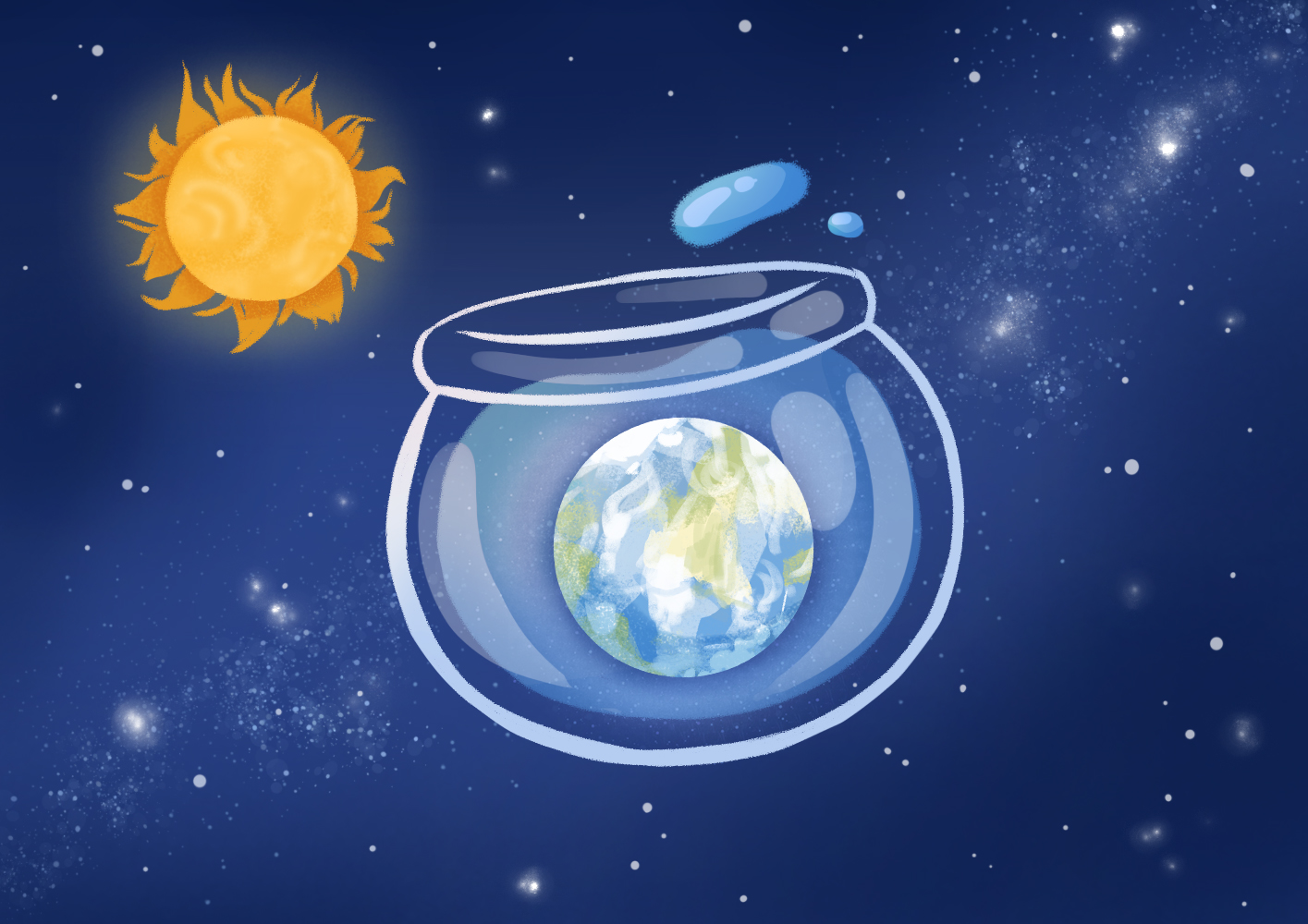
Various goldfishes will differ in their ability to conquer parts of their own "Paraquarias" (environments) and take over the space they vitally need, but there is one critical rule that determines this ability. This will be our Observation Six and let me now share it with you.
ABILITIES — ONE UNIVERSAL RULE







Consider this: every time Goshio approaches the "perilous" border between the two worlds, her own beloved Aquaria and the grand world of Paraquaria, she senses infinite, nameless terror.
The ability to expand the aquarium walls and consequently widen one's field of view, as well as increase the actual volume of the aquarium, mainly depends on how much and how well our goldfish understands the world (environment) beyond those walls. The environment does affect the aquarium significantly and it also dictates both the speed and the direction of motion for Aquaria and all its happy and lively residents. Lacking knowledge about the outside world, the goldfish will be reluctant to even approach the aquarium frontiers and will instead choose to stay in safe, if very constricting, waters – away from the unknown and unexplored currents of the Paraquarian World.
Observation Six: Freedom or Comfort?














EXPANDING THE AQUARIUM WALLS REQUIRES KNOWLEDGE
of the outside world
of the outside world







CERTAINTY
UNCERTAINTY
I DON'T KNOW WHAT'S THERE :-(
THE UNKNOWN
Yet whichever way you look at it, in her quest for freedom, Goshio will have to become a pioneering explorer of heretofore uncharted Market Vastnesses of Paraquaria and gain knowledge (or even discover the secrets) of territories beyond the confines of her aquatic world; also, she will have to meet (better yet – befriend) the creatures of the world beyond. And this leads us to Observations Seven, Eight and Nine.







FREEDOM
COMFORT
or










TRAVELERS' GUIDE to PARAQUARIA

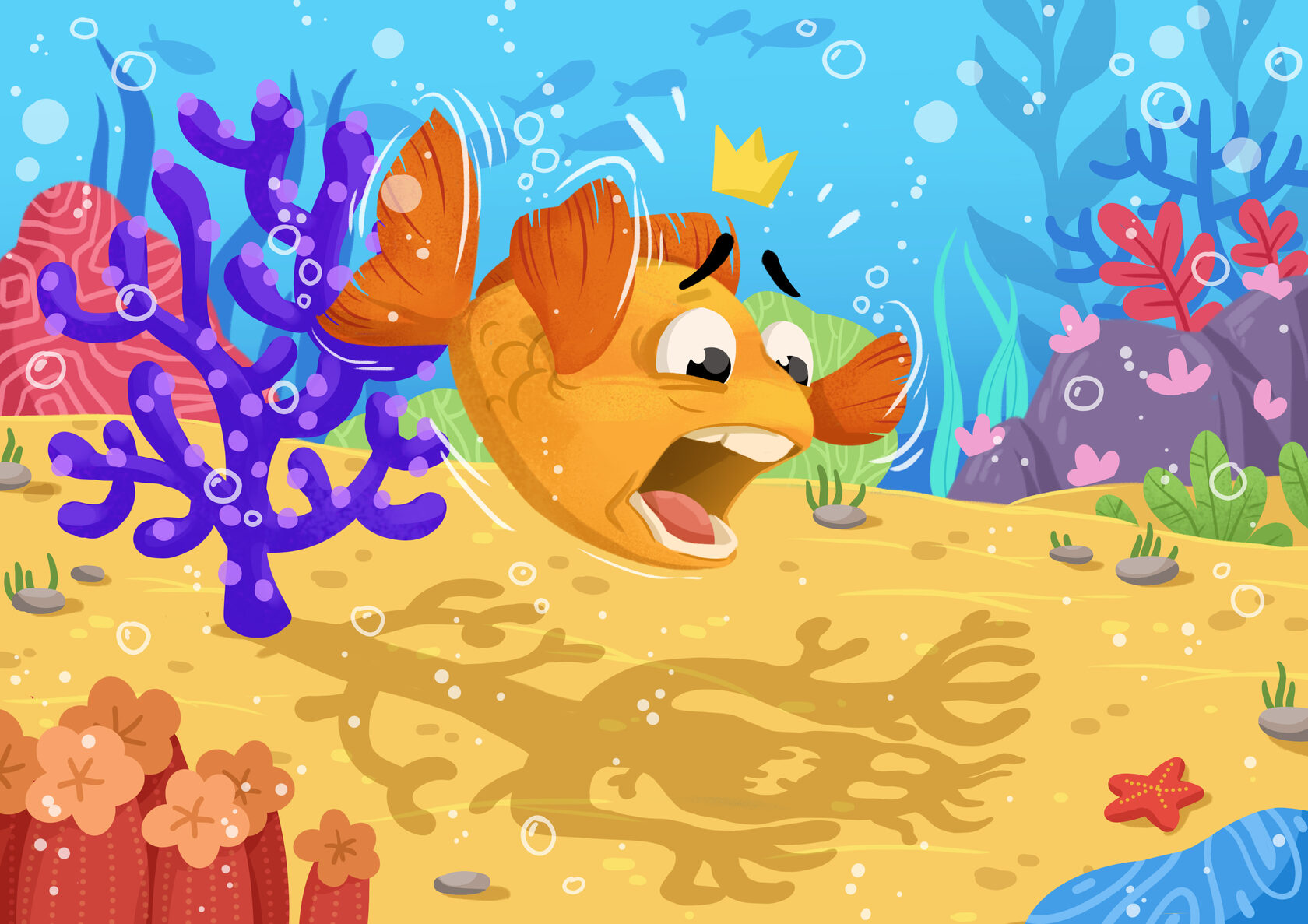
Speaking of worldviews – the differences between them can be demonstrated by another important philosophic principle: Where the Entrepreneur chooses to begin the problem-solving sequence and where he or she sees fit to end it, depends solely on the individual's convictions and assumptions – in other words, on the Entrepreneur's own worldview.
Directing her attention to the outside world and setting out on a voyage of exploration requires that Goshio would first change her own worldview. Her current outlook on life brought about a certain resistance to change and permitted a comfortable (if limited) gold-fishean existence – reflected in the mirror of her life by all the things she has grown accustomed to from her first beginnings. This error is what played such a devilish prank on our goldfish and "immured" her inside the aquarium.
Observation Seven: Don't Resist Changes




COMPLETE SHIFT IN WORLDVIEW
IT IS CRUCIAL TO CHANGE ONE'S OWN PERSPECTIVE











One's worldview determines the starting point of the decision-making sequence
CONVICTIONS
ASSUMPTIONS
WORLDVIEW




NO NEED to RESIST CHANGES






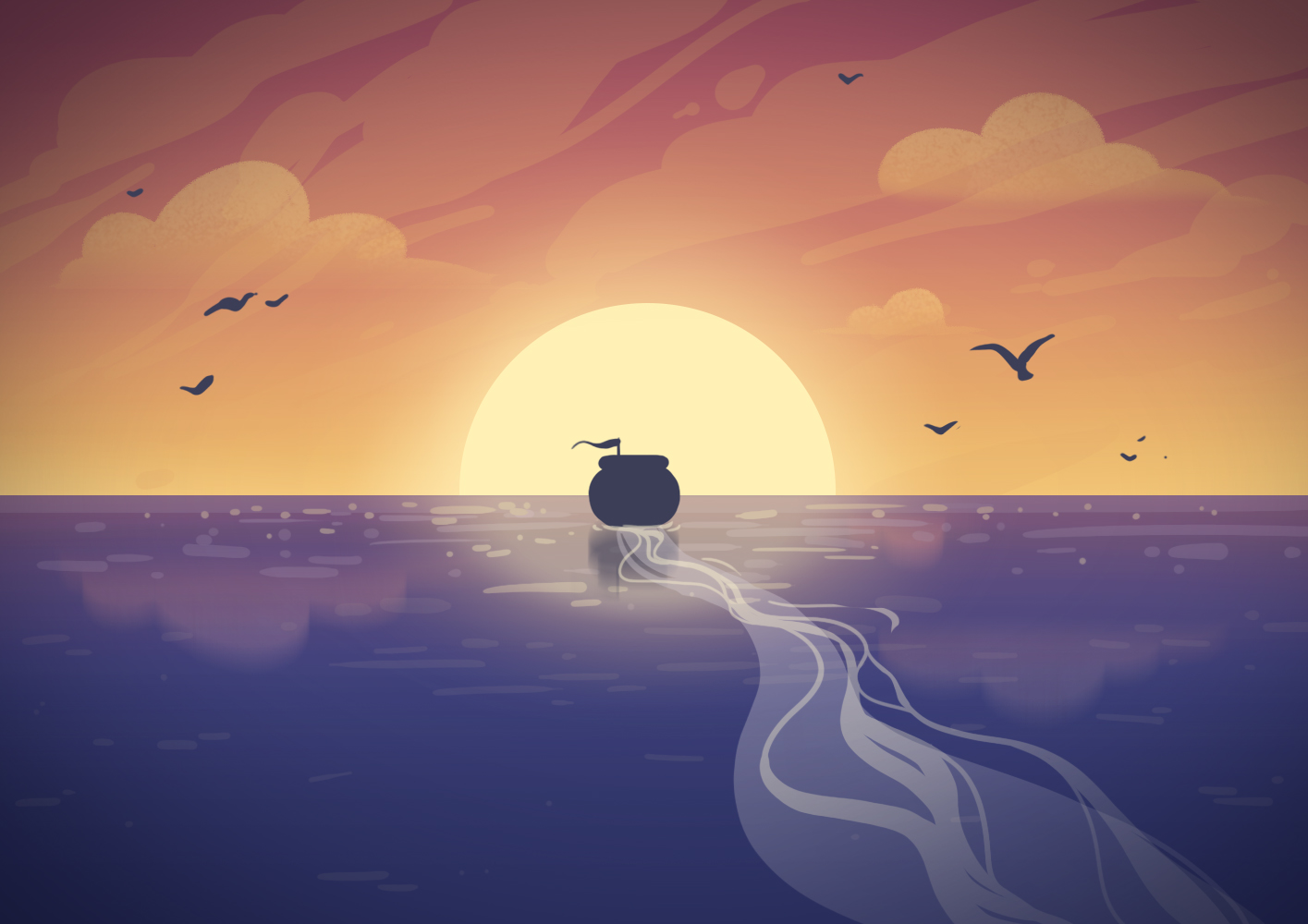
Expanding on our analogy from Observation One, let us say that we have a painting delineated by the borders of square C, which includes two smaller squares: B and A. Now let us assume that the segment outlined by square A is the only part of the painting we can directly observe, while the rest (outside the borders of A) is imperceptible to our observation. In this case, we will not be able to identify or envision the painting illustrated by the entire square C – after all, we can only see a section of it enclosed by A, while a vague (or very clear) feeling deep inside is gnawing at us, hinting there is something more… Naturally, we can try to surmise what might be depicted in squares B and C using only the fragment portrayed in A, but in this case our prediction is only in the realm of possibility. We know this. We feel our own ignorance and "blindness," our uncertainty, and hence – our fear. This occurrence is the main reason for uncertainty in our lives – we are forced to discern the whole "canvas of life" through no more than a tiny fragment that we can directly observe, perceive and comprehend. And this brings us to the next Observation, number Nine.
Observation Eight: Fear of the Unknown
To be effective in her quest outside the aquarium, goldfish Goshio will need to overcome her fear of the unknown. Such fear always stems from complexity and uncertainty – in other words, it is a symptom of not understanding the environment. Fear and ignorance are related phenomena.
To be effective in her quest outside the aquarium, goldfish Goshio will need to overcome her fear of the unknown. Such fear always stems from complexity and uncertainty – in other words, it is a symptom of not understanding the environment. Fear and ignorance are related phenomena.





A
B
C


EXTENT of OBSERVED PICTURE
WHOLE PICTURE




Very scary
Not scary
Nothing is known
Everything is known
FEAR AND IGNORANCE
are related phenomena


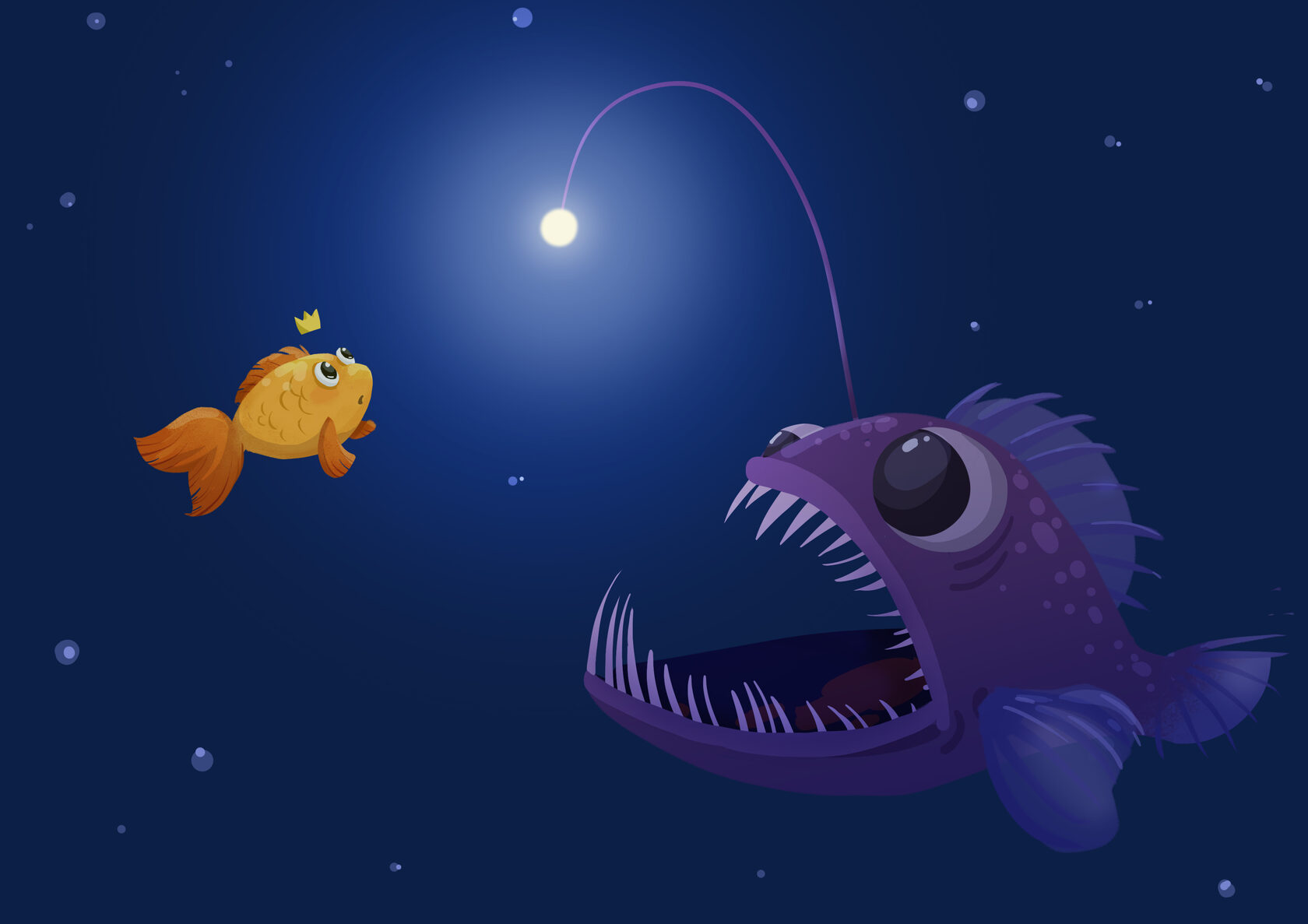
When we are observing only a part of the whole picture (like Circle A on the illustration), we might perceive that segment as if it were the whole picture (Circle B) and then paint the remaining touches in with our imagination. This leads us to conceiving a final version of the object, a version that is clear and logical to us (Circle C).
Except the true object (giraffe) and the counterpart we have ever so cleverly imagined from observing only a part of the giraffe are two completely different things.
Except the true object (giraffe) and the counterpart we have ever so cleverly imagined from observing only a part of the giraffe are two completely different things.
Observation Nine: Part or Whole?
We can continue our example, drawing a comparison to Entrepreneurship and illustrating a mistake in choosing one's target audience. Let us say the Entrepreneur has a product, a covering for the teeth made from a firm elastic material. In dentistry this is known as "aligners." The Entrepreneur developed and manufactured these standard aligners – they have been serially produced and distributed on the market. Yet the market is just not buying them somehow. Why? – Good question. Because in our example, the true target audience on the market are giraffes – there are no crocodiles (or even alligators, for that matter). Yet our Entrepreneur was so certain that he had seen only crocodiles on the market (to him, there were no giraffes!), and therefore a product was created to fit the teeth of a crocodile. But unfortunately, giraffes have a somewhat different jaw structure than crocodiles, and crocodile aligners are a bad fit for giraffes. The worst of it, though, is that giraffes have front teeth only on their lower jaws and no front teeth on top! But what they do have on their palate is a firm dental pad. The giraffe uses his bottom teeth to press twigs and branches against this pad on top and squeeze the twigs tight, pulling his lunch off the trees and bushes. But now, lamentably, the giraffe finds himself in a predicament in which his "extra teeth" from the crocodilian aligners not only get in the way of biting off branches, but also hinder him from closing his mouth. Alas, giraffes simply cannot walk around for long with their mouths open. All in all, giraffes were not very fond of this contraption and buy it no more. And that is how it all came to pass. At first glance, My Reader might think that I went a tad or a lot overboard with this example. I would concur. But if you take a close look around, I am almost fully certain that you would find many "living and breathing" examples of equivalent mistakes.







AN ATTEMPT TO UNDERSTAND A WHOLE BY ONE OF ITS PARTS CAN LEAD TO MISTAKES
А
B
С










TARGET AUDIENCE: THE IMPORTANCE OF HITTING THE BULL'S EYE
Assumed Target Audience
PRODUCT
fits
doesn't fit
Actual Target Audience



PART or WHOLE?
I AM NOT A CROCODILE!
???



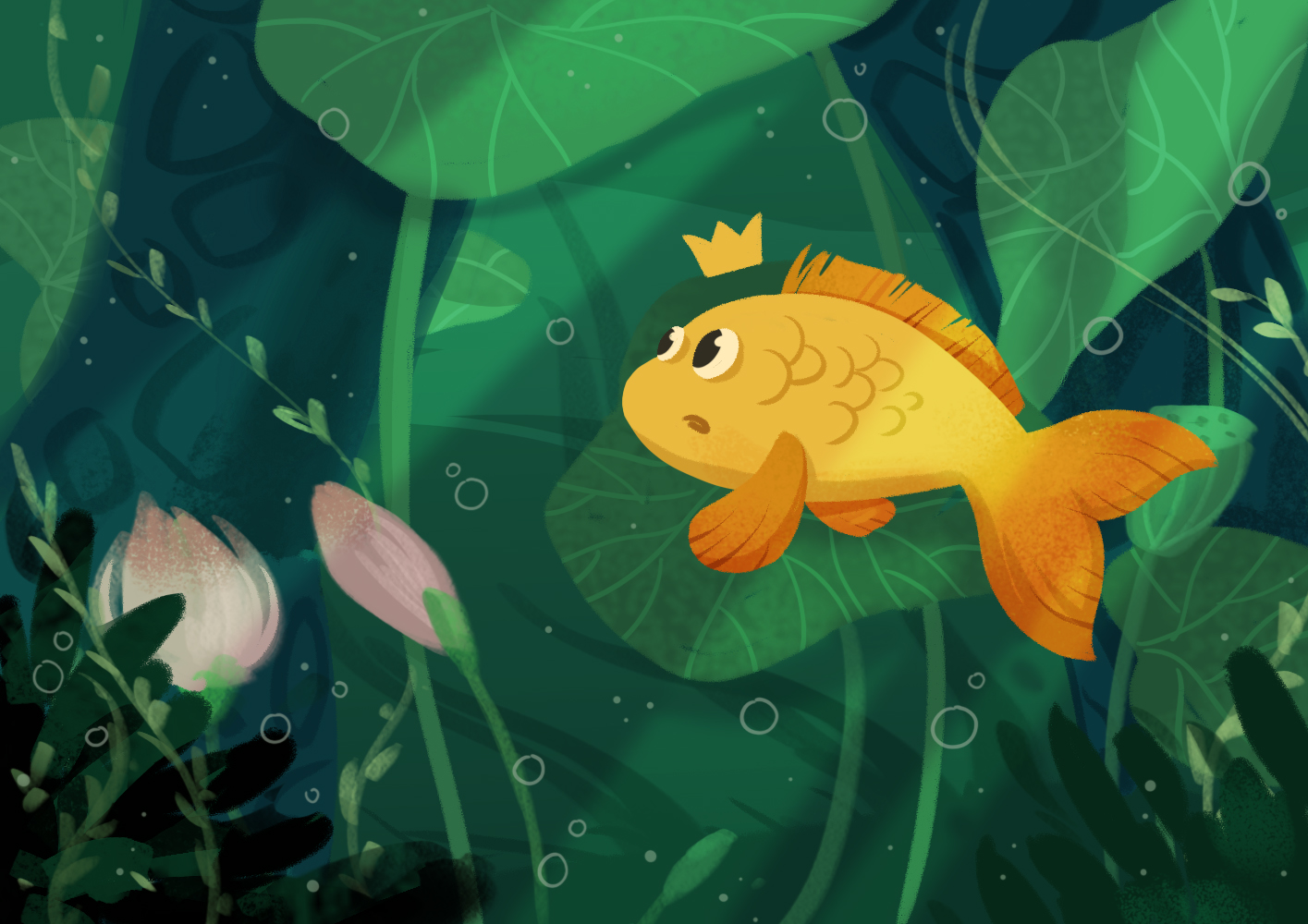
The current aquarium boundaries can be "calculated" by using four very magical steps. Before I list them, it is only fair to explain why you would even wish to calculate the boundaries of your own "Aquaria." There are various reasons, but one significant point comes to mind: if you know where your "Aquaria" ends and "Paraquaria" begins, you also know who is friend or foe, teammate or rival – or, perhaps, not a rival, but a person who is simply not on your team. You know exactly where your loyalties lie and what the basis for decision-making should be. That is not to say that we wish ill or intend to wage actual war on "Paraquaria" (war is a game of madmen) – no, we are interested in a broad panorama and a win-win scenario. And yet, understanding clearly where the bounds of the playing field lie, where your own goal is and who your true teammates are cannot hurt, right? That helps us avoid blunders like scoring into our own goal or slide-tackling our very own teammates – a mistake that, alas, gets made all too often in life.
Our tenth and final Observation could be called the secret of success. It revolves around helping our beautiful goldfish learn to do two things: determine the right dimensions for her aquarium and understand the basic principles of how her environment operates. Now we segue into that final Observation.
Observation Ten: Evaluate Your World (or The Magic Formula of Goshio)
Observation Ten: Evaluate Your World (or The Magic Formula of Goshio)







a
b
X
R
Y
EVALUATING THE ENVIRONMENT































STEP ONE:
Deciding which problems are worthwhile subjects of study
Deciding which problems are worthwhile subjects of study





























STEP TWO:
Determining what approaches are suitable for analyzing the problems
Determining what approaches are suitable for analyzing the problems



































STEP THREE:
Coming up with acceptable explanations of why these problems exist
Coming up with acceptable explanations of why these problems exist









































STEP FOUR:
Selecting the best methods for effectively solving the problems chosen
Selecting the best methods for effectively solving the problems chosen

























DIFFERENCES BETWEEN AQUARIUMS
Now that I offered a reason why, let us look at how the calculation is done. Step one is for a goldfish to decide which problems it finds to be worthwhile subjects of study in its current life and activities.
Step two is determining what approaches are suitable for analyzing these problems.
In step three, the goldfish needs to come up with acceptable explanations of why these problems exist – acceptable to the goldfish itself, that is. (Curiously, any explanation will bring it some peace, but only the right one will truly help).
Finally, step four is selecting the best methods for effectively solving the problems chosen.
This tells us that two or more different "aquariums" would give us very distinct formulations of problems, differing methods of analyzing the problems, varying explanations for the existence of these problems, and unique solution approaches. So, we see that similarities and differences between two or more "aquariums" are determined specifically by these four key parameters.
WHY BOUNDARIES?
And that is the magical, if simple, secret of success. But a more detailed narration of that secret is quite another story, Dear Reader, and shall be told another time.








FOUR STEPS
Deciding which problems are worthwhile subjects of study in one's current life and activities
Determining what approaches are suitable for analyzing these problems
Coming up with acceptable explanations of why these problems exist
Selecting the best methods for effectively solving the problems chosen

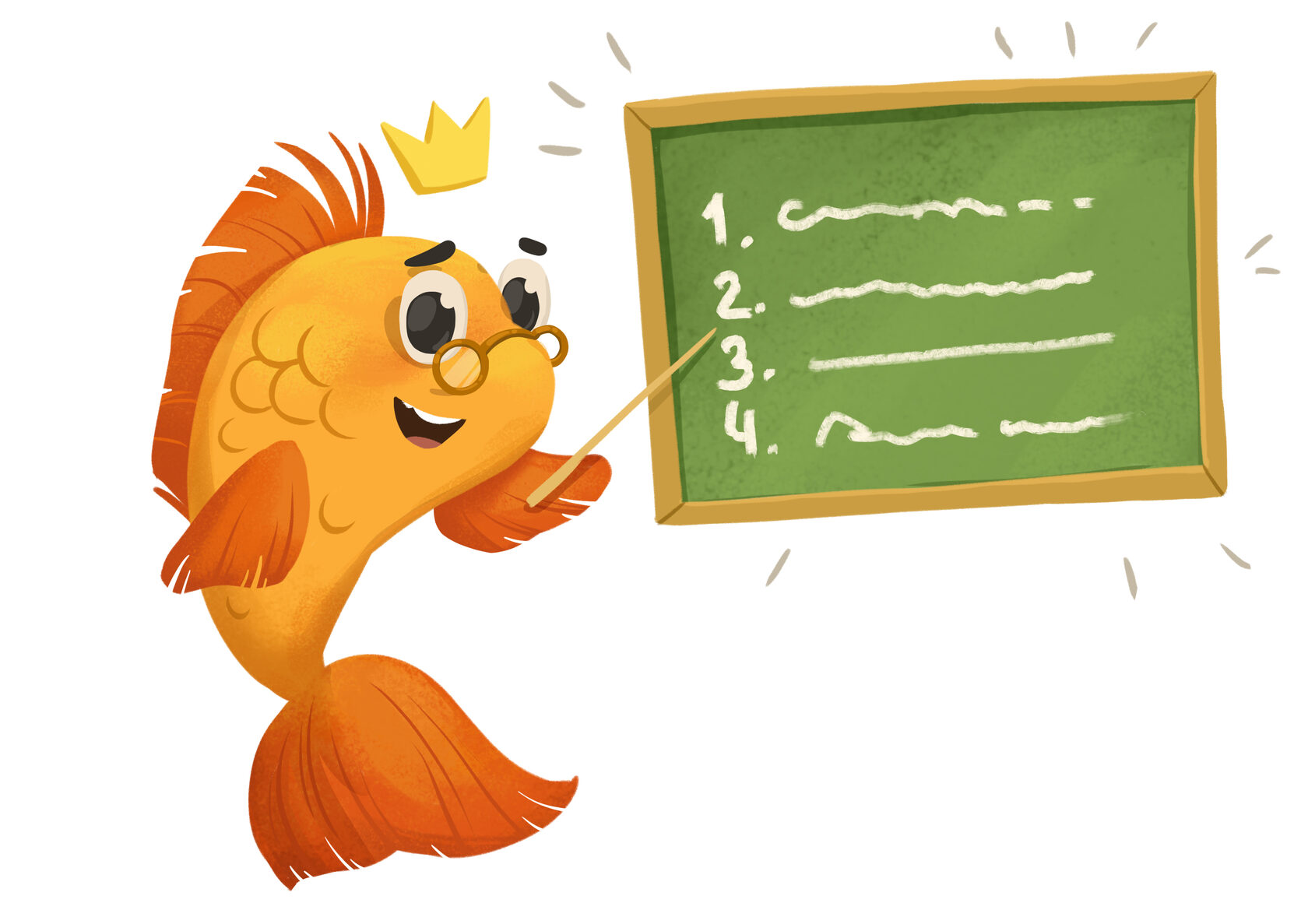
If we cannot compare and differentiate, then how could we ever shed light on why, for example, one goldfish survives in its aquarium while other goldfishes in neighboring aquariums perish? And that is precisely why the ability to differentiate is the Holy Grail of art, the art of Entrepreneurship and of human relations, and even the art of living itself.
We could call this our very final, unplanned and bonus observation…
In real life, the ability to compare and the ability to differentiate are interwoven together, and this latter ability is the keystone for any mindful and conscious human activity. I might add that the ability to differentiate also happens to be the cornerstone of sanity itself. You would agree, I think, that if a person cannot differentiate between a toothbrush and tooth paste or cannot tell apart a taxi and a squad car, if one begins to confuse chairs with chains, tables with fables or if an observer cannot make out even slight yet vital distinctions between things like chair and armchair or azure and blue – then something unpleasant is bound to happen at last.
In real life, the ability to compare and the ability to differentiate are interwoven together, and this latter ability is the keystone for any mindful and conscious human activity. I might add that the ability to differentiate also happens to be the cornerstone of sanity itself. You would agree, I think, that if a person cannot differentiate between a toothbrush and tooth paste or cannot tell apart a taxi and a squad car, if one begins to confuse chairs with chains, tables with fables or if an observer cannot make out even slight yet vital distinctions between things like chair and armchair or azure and blue – then something unpleasant is bound to happen at last.
Bonus Observation: Learn to Differentiate
THE ABILITY TO COMPARE AND DIFFERENTIATE
LEARN TO DIFFERENTIATE
dead fishes

















Information
A
B
Information
more
less





pebbles
live fish
water with oxygen
container
pebbles
container
water without oxygen
live fish
living fishies
INTERACTION OPTIONS


IT'S USEFUL TO STUDY AQUARIUMS
By parts and by interaction
OBSERVED PICTURE
IDENTIFICATION OF DIFFERENCES
COMPARISON
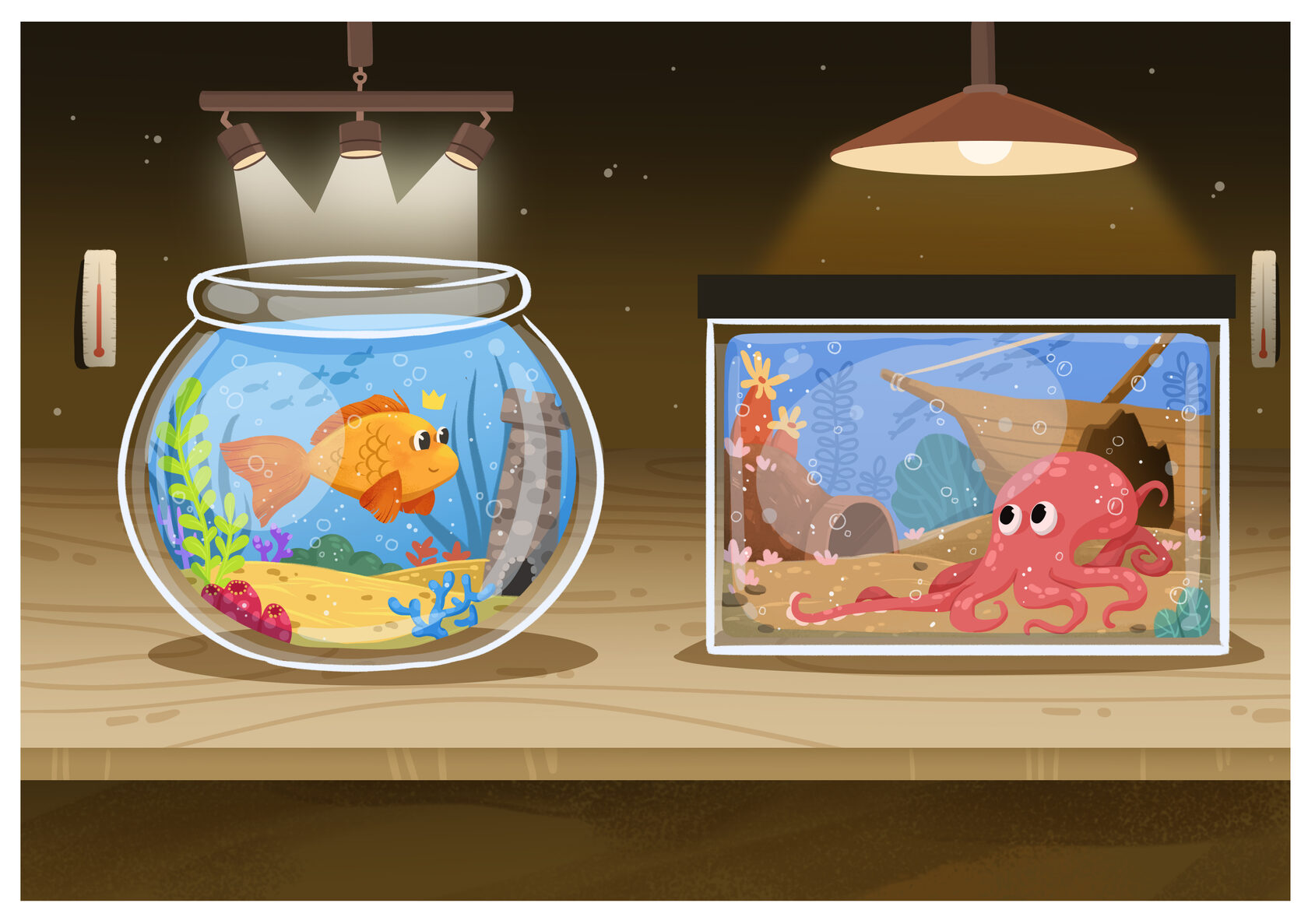
Afterword
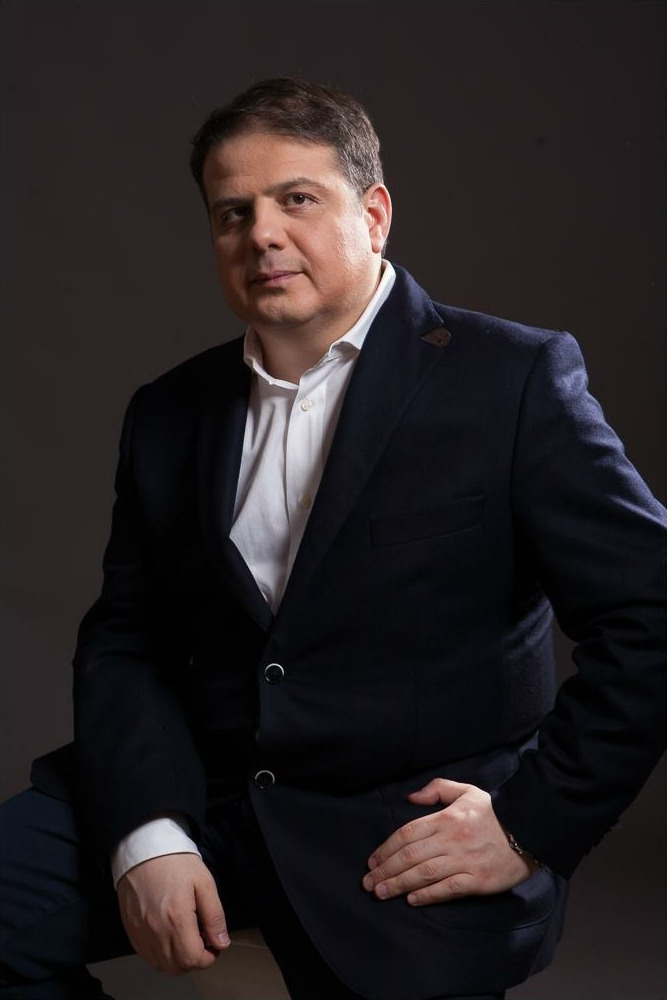

Thank you, My Reader, for taking the time to meet Goshio the Goldfish.
In my fable I have used the word "Observation" to describe a certain point, fact or circumstance that influences the situation in Aquaria as a whole and affects each particular result our Goshio wants to achieve.
All these Observations are closely related, and it is often impracticable to draw a clear boundary between them. Usually, the Observations (or more precisely, the concepts they represent) are all so tangled in the minds of people, so entwined into an inextricable and complex ball of thoughts, ideas and perceptions, that the result is a true labyrinth – one, I should mention, where Goshio might meet creatures ghastlier than the Minotaur himself. And valiant though she might be…
Coming back to the real world of Entrepreneurship, let me mention that these "puzzle pieces" – thoughts, ideas and perceptions about business – blend together into all kinds of puzzled thinking paradigms among goldfishes – Entrepreneurs, that is.
Nevertheless, each of the Observations zeroes in on one specific aspect of such thinking with the aim of helping the reader examine these thought processes from utterly different and, at times, most startling aspects.








Dearest Reader…Alas, fables and fairy tales (even entrepreneurial ones) tend to end, and so it is time to say good-bye or, rather, "Until we meet again!".
And yes, I am certain that we shall definitely meet again soon on the raging and stormy market waves of Paraquaria – meet and sail away from the warm and cozy aquarian currents of the old familiar world so swiftly disappearing into the voracious vortex of nothingness.
And, as fairy tales often end in my culture: if you grasped the fable well, thank you, Friend, and all is swell!
Truly and Goshianically yours,
Jaroslavs Kaplans
Jaroslavs Kaplans
Language
English
Deutsch [German]
Français [French]
Español [Spanish]
Italiano [Italian]
Português europeu [Portuguese]
Português (Brasil) [Brazilian Portuguese]
Latviešu [Latvian]
Русский [Russian]
Українська [Ukrainian]
Ελληνικά [Greek]
中文(台灣) [Traditional Chinese]
中文(中国)[Simplified Chinese]
日本語 [Japanese]
العربية [Arabic]
Deutsch [German]
Français [French]
Español [Spanish]
Italiano [Italian]
Português europeu [Portuguese]
Português (Brasil) [Brazilian Portuguese]
Latviešu [Latvian]
Русский [Russian]
Українська [Ukrainian]
Ελληνικά [Greek]
中文(台灣) [Traditional Chinese]
中文(中国)[Simplified Chinese]
日本語 [Japanese]
العربية [Arabic]

